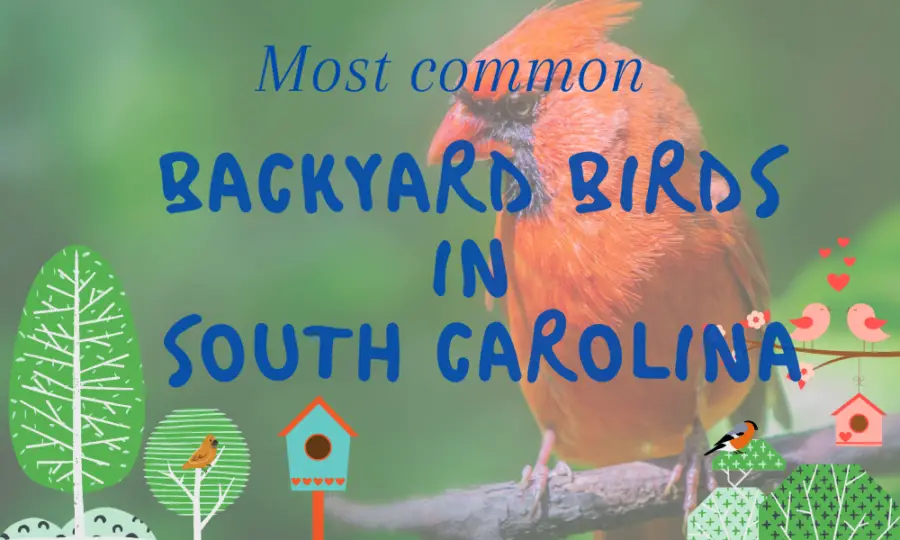I always thought of birds as beautiful and interesting creatures that keep our backyards lively year-round – but especially in the summer!
They fly through the sky, visit our trees and feed at our bird feeders, giving us something to observe from our living rooms and keeping us company when we are outside. But have you ever wondered what each of them is called, where they live, and what they eat?
Then you have come to the right place! I am going to guide you through each of the most common birds observed in South Carolina. Most are observed year-round, but I will focus on those you see during the warmer months of the year.
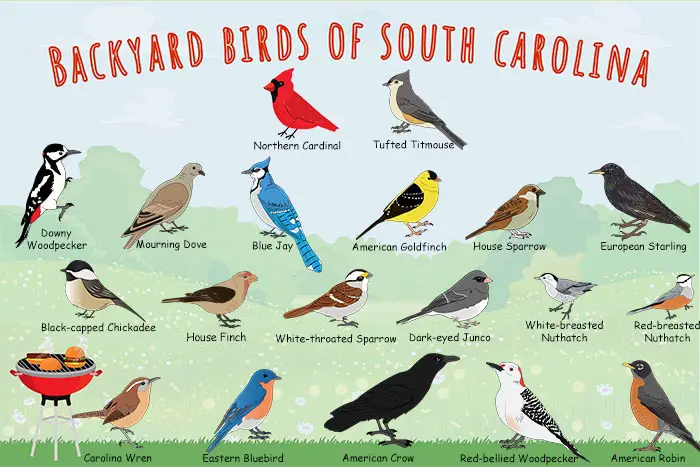
In this post I will answer questions such as:
- What are the most common backyard birds in South Carolina?
- How do I identify the birds in my backyard of South Carolina?
- What is the likelihood that a specific bird visits my bird feeder in South Carolina?
- How do I attract my favorite bird to my bird feeder in South Carolina?
- What bird feeder to use, to attract specific birds to my South Carolina backyard?
Contents
Top 30 backyard birds of South Carolina:
| No | Bird | % of all counted birds | % of total visits | Avg. Group size |
| 1 | Northern Cardinal | 7.8 | 90.1 | 4 |
| 2 | Carolina Chickadee | 3.8 | 86.2 | 2 |
| 3 | Carolina Wren | 2.8 | 80.4 | 1 |
| 4 | Tufted Titmouse | 3.3 | 80.2 | 2 |
| 5 | House Finch | 6.6 | 74.9 | 4 |
| 6 | Mourning Dove | 5.9 | 71.7 | 4 |
| 7 | Downy Woodpecker | 1.9 | 60.7 | 1 |
| 8 | Red-bellied Woodpecker | 1.6 | 55.7 | 1 |
| 9 | Eastern Bluebird | 2.9 | 51.7 | 2 |
| 10 | American Goldfinch | 5.9 | 51.1 | 5 |
| 11 | Chipping Sparrow | 7.1 | 45.6 | 7 |
| 12 | Yellow-rumped Warbler | 2.9 | 45.2 | 3 |
| 13 | Blue Jay | 2.1 | 43.8 | 2 |
| 14 | Pine Warbler | 1.6 | 43.3 | 2 |
| 15 | Northern Mockingbird | 1.2 | 43 | 1 |
| 16 | White-throated Sparrow | 2.7 | 40.1 | 3 |
| 17 | Brown-headed Nuthatch | 1.1 | 32.6 | 1 |
| 18 | Brown Thrasher | 0.9 | 30.9 | 1 |
| 19 | White-breasted Nuthatch | 0.7 | 26.5 | 1 |
| 20 | Pine Siskin | 5.7 | 25.7 | 10 |
| 21 | Purple Finch | 1.9 | 24.9 | 3 |
| 22 | American Robin | 3 | 22.1 | 6 |
| 23 | American Crow | 1.5 | 21.4 | 3 |
| 24 | Brown-headed Cowbird | 3.6 | 20.3 | 8 |
| 25 | Eastern Towhee | 0.7 | 19.9 | 1 |
| 26 | Ruby-crowned Kinglet | 0.5 | 19.9 | 1 |
| 27 | Dark-eyed Junco | 1.5 | 17.7 | 4 |
| 28 | Red-winged Blackbird | 3 | 15.9 | 8 |
| 29 | Baltimore Oriole | 1.2 | 15.1 | 3 |
| 30 | Common Grackle | 2.3 | 14.2 | 7 |
Backyard birds show some interesting trends in South Carolina!
When looking at the graph below, we can see that almost all the birds have gained more interest in visiting backyard bird feeders since 1988:

So from the graph above, it is clear that the Northern Cardinal (dark yellow line) has been the most frequent visitor of bird feeders in South Carolina for almost 30 years (except for 1988 and 2015!).
Whereas the Northern Cardinal is just about holding on to its top position as the most common bird of South Carolina, other birds such as the House Finch and the Downy Woodpecker are rapidly on their way towards the top!
Read on for much more detailed descriptions and statistics for the most common birds in the state of South Carolina!
Northern Cardinal (Cardinalis cardinalis) in South Carolina
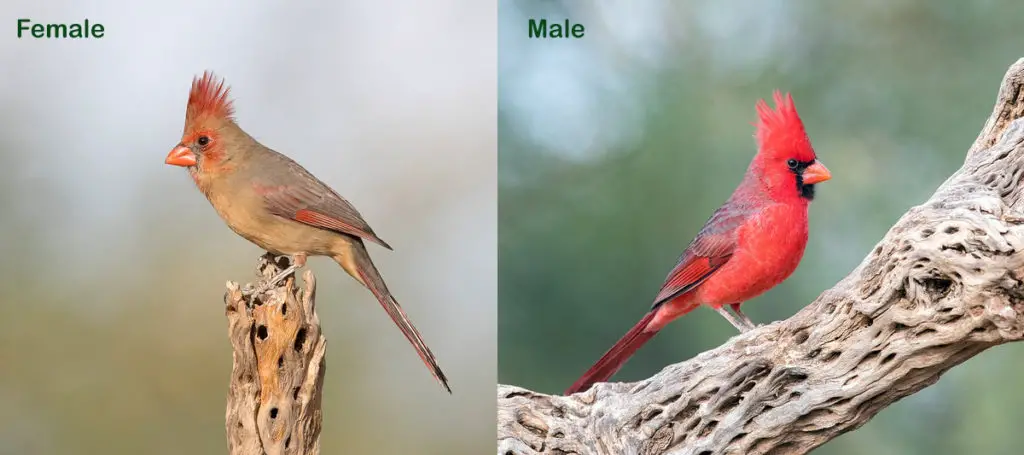
Family: Cardinalids
Origin: Southeastern US.
Diet in the wild: Insects, seeds, berries, flowers.
Feeder type preferences:
Feeder food preferences:
Endangered: No.
The Northern Cardinal is a common and very popular backyard bird seen throughout North America. Depending on where you live, you may give the Northern Cardinal nicknames such as: the red cardinal, common cardinal, redbird, or simply cardinal. Its many names exemplify its representation of the wider cardinal family, Cardinalidae, which includes several other common birds such as the Dickcissel, some grosbeaks, and the buntings.
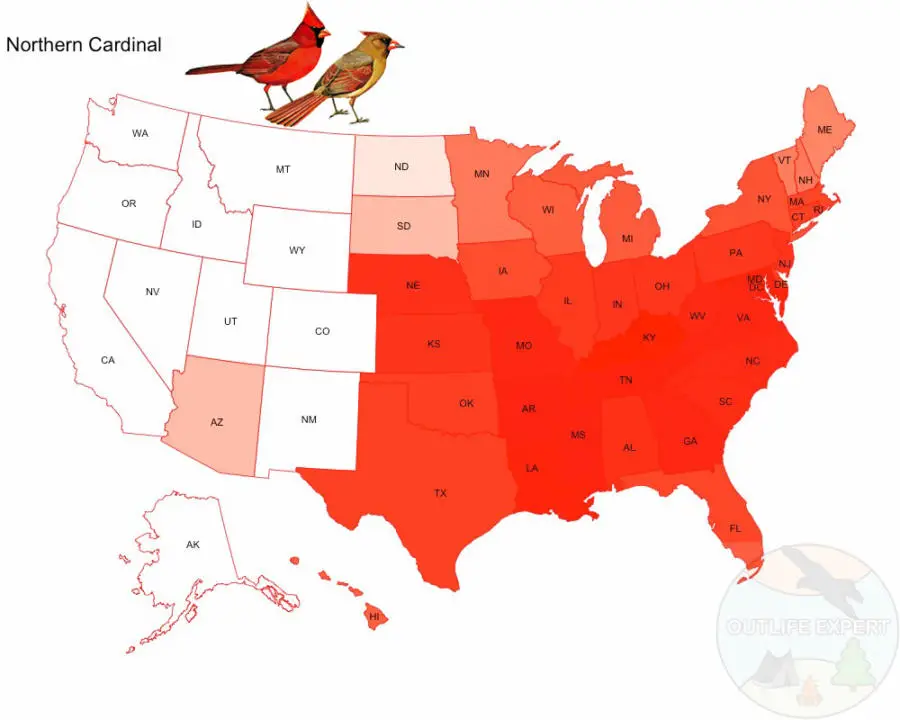
The stronger the red color, the higher the chance that you will see the Northern Cardinal in your backyard.
How and where to spot the Northern Cardinal
The Northern Cardinal is native to the Southeastern United States, where it is the official state bird of several states: West Virginia, Indiana, Virginia, Ohio, Ilinois, Kentucky, and North Carolina. Furthermore, several institutions, including sports teams such as the St. Louis Cardinals and Arizona Cardinals use it as their mascot.
At the national level, the population is stable over time and the majority of observations of the Northern Cardinal have been made in the Eastern parts of the US.
Many Cardinalids are strongly colored, making them easy to spot at the bird feeder. Especially the brightly blue Indigo Bunting and the multicolored Painted Bunting are amazing examples of this colorful family.
The male Northern Cardinal is easy to recognize as it is the only bright red bird seen all year round in the Northern parts of the US.
The female is predominantly brown and less brightly colored which may lead to confusion with other Cardinalids, for example, its Pyrrhuloxia, Summer Tanager, or Hepatic Tanager cousins.
These cardinals, however, are more widespread in the southwestern states and northern Mexico where the Northern Cardinal is less common.
All Cardinalids are highly vocal, and the Northern Cardinal comes across as exceptionally noisy, boasting a loud metallic voice with which it sounds the characteristic ìtik-tikî call or a softer slurred whistle.
Whereas some cardinals are brightly colored throughout their entire body, the Pyrrhuloxia, which has a parrot-like bill and is considered the Southwestís equivalent of the Northern Cardinal, is gray with crimson red patches throughout its body.
Red birds in South Carolina
Red birds are easy to spot due to their strong colors, and most people notice them easily at bird feeders. If you live in South Carolina and observee a flock of red birds, they are likely to be Northern cardinals! These little birds are known for their bright colors and are most often the birds people think of when asked to imagine a red bird in the US.
The Northern Cardinal is indeed the most common bright red bird in South Carolina. But there are also other red birds in South Carolina, such as the House Finch or the less common Purple Finch and you may even spot the (male) Summer Tanager or Scarlet Tanager (or some of the other Tanagers mentioned above) if you are lucky!
In the Eastern US, you are mostly correct in assuming the Norhern Cardinal is the most common bright red visitor!
Habitat and mating of the Northern Cardinal
It prefers relatively moist habitats, such as deciduous woodlands, scrublands, desert washes, and backyards. Their breeding season is March-August where the male is particularly aggressive and repels any intruder. He is so aggressive that he will occasionally confront his own reflection in windows and various shiny surfaces.
The nest of the Northern Cardinal is somewhat flimsy with thin barks, grasses, and leaves. However, it is also ìsingle-useî as they do not usually use the nest again the coming year. The female lays 2-4 turquoise brown-spotted eggs per nest, an effort which it may repeat up to four times per year!
What does the Northern Cardinal eat and how do I attract it?
The Northern Cardinal diet consists mainly of seeds and fruits whereas the young receive mostly insects from their parents. The Northern Cardinal feeds on many different seeds at bird feeders, but feeders with corn, oats, safflower, and especially sunflower seeds seem to be especially popular with the Northern Cardinal.
The preferred foods of Northern Cardinals in the wild include:
- crickets
- buckwheat
- flies
- moths
- spiders
- centipedes
- cicadas
- beetles
- grass
- butterflies
- seeds
- sumac
- mulberries
- hackberry
- blackberry
- wild grape
The population of Northern Cardinals is doing well in South Carolina and their numbers are luckily increasing after being fairly constant for many years.
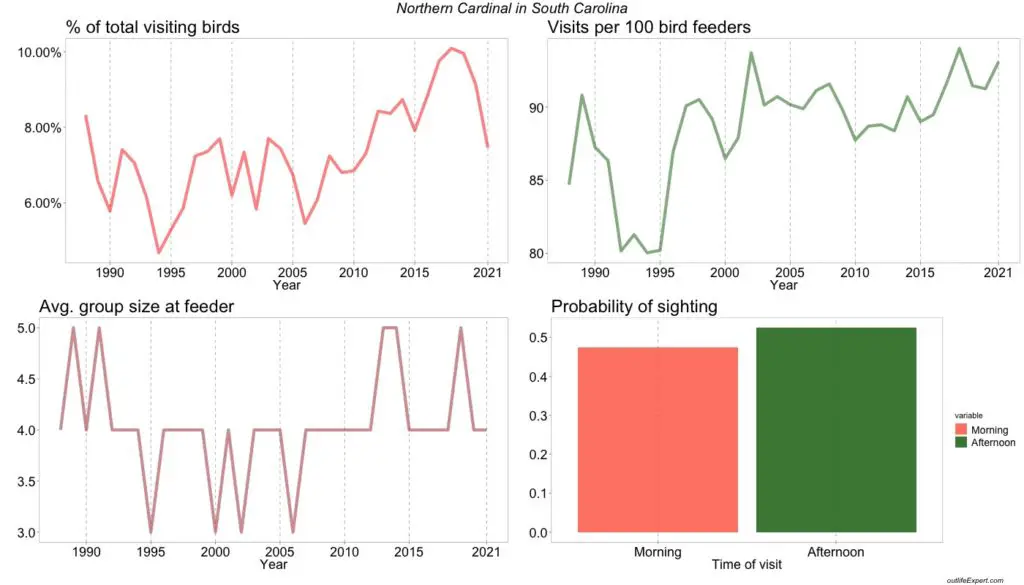
% of total visiting birds: The proportion of the specific bird out of the total number of birds observed bird feeders in this state.
% of total feeders visited: The proportion of feeders (out of all participating feeders in the state each year) where the bird was observed at least once within 2 days.
Avg. group size at feeder: The average number of birds counted simultaneously for each bird feeder observation.
Probability of sighting: The chance of spotting the bird in either morning (before 12 noon) or afternoon (after 12 noon). If both are 0.5 there is an equal chance of spotting the bird in the morning and afternoon.
Carolina chickadee (Poecile carolinensis) in South Carolina
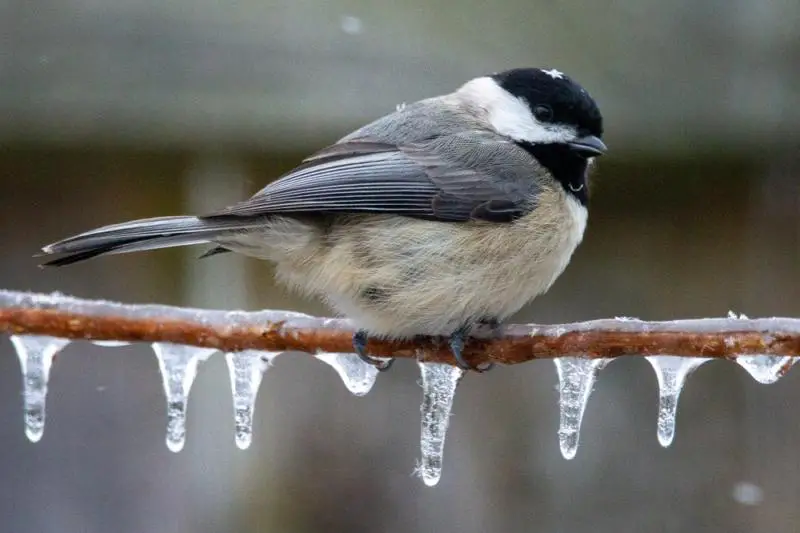
Carolina Chickadee summary:
Family: Paridae
Occurrence: Mid-Atlantic, midwestern, and southeastern United States.
Diet in the wild: Mostly insects, berries and seeds.
Feeder type preferences:
- Large tube feeder
- Ground feeder
- Platform feeder
- Window feeder
- Small hopper feeder
- Large hopper feeder
- Suet Cage
Feeder food preferences:
- Black Oil Sunflower Seeds
- Hulled Sunflower Seeds
- Safflower
- Whole peanuts
- Nyjer seeds
- Mealworms
- Crushed peanuts
- Suet
Endangered: No.
Carolina Chickadee (Poecile carolinensis)
The Carolina Chickadee belongs to the family of Chickadees and Titmice (Paridae). The Carolina Chickadee was named by John James Audubon while he was in South Carolina. You may recognize this name, as Audubon was a renowned ornithologist and creator of The Birds of America book.
It is a permanent residence of the mid-Atlantic, midwestern, and southeastern United States, and does not migrate. Look for the Carolina chickadee in deciduous and mixed deciduous-coniferous woodlands, orchards, gardens, swamps, along rivers and streams, open woods, parks, urban and suburban yards, and feeders.
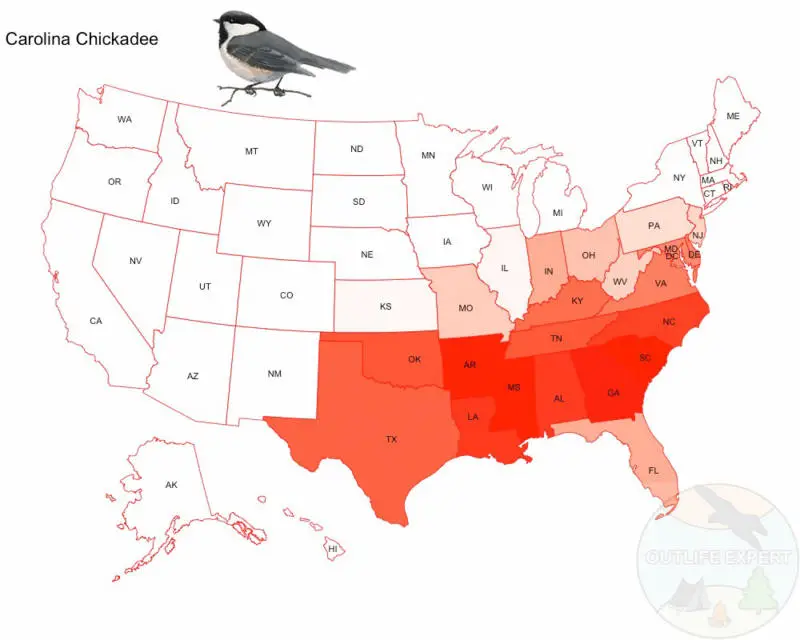
Identification & Confusion with Black-capped Chickadees
Carolina Chickadees are small birds (smaller than white-breasted nuthatch for reference) with a short neck, large head, spherical body shape, and a long, narrow tail. Itís plumage on the back, wings, and tail are a soft gray, with a black cap and bib separated by white cheeks. The Carolina Chickadee is almost indistinguishable from its relative, the Black-capped Chickadee. These two species diverged more than 2.5 million years ago. The two best ways to distinguish these two species are the range and the song of the birds.
Both chickadees have distinct ranges, with a very narrow area of contact or overlap. The Black-capped Chickadees is widespread across North America, but has greater western and northern distribution. The contact zone between the two chickadees is along the narrow northern border of the Carolina Chickadeesí range. The Carolina Chickadeeís western range is limited to parts of Kansas, Oklahoma, and Texas, where the Black-capped Chickadee doesnít live.
The Carolina chickadee has a higher pitched and faster song, with 4 whistle notes. Whereas the Black-capped Chickadeeís song is lower in pitch, slower, and has only 2 or 3 notes. In the contact zone where both Chickadees can be found, these birds can learn to imitate each otherís songs, making for a very confused birdwatcher!
Breeding
Carolina Chickadees form mating pairs in the fall and stay together as part of the winter flock. Near the end of the winter when the flock disperses, the pair will establish a nesting territory. Pairs can stay together for several years or even for life.
Carolina Chickadees make their nest in a tree cavity or nest box. The pair will either find or excavate a tree cavity together, usually 2-25 feet high in the tree. Carolina Chickadees have to compete with Downy Woodpeckers, Tufted Titmice, and Brown Creepers for these cavities. When the nest is near the edge of a forest, 50% of all cavities will face the open clearing. The female builds the nest within the cavity, starting with moss and strips of bark as a base, and then adding a thick lining of hair and plant fibres.
In breeding season from February to April, Carolina Chickadees will typically have only 1 brood, with 3-10 eggs. The females incubate the eggs for 12-15 days, and then the nestlings will leave the nest after 16-19 days. Both parents will forage to feed the nestlings. Both birds will make a loud hissing sound, like a snake, if disturbed in and around the nest as a tactic to ward off potential predators or other birds.
While nesting, the female will sleep in the nest cavity, while the male sleeps on a sheltered branch, vine or shrub nearby. Outside of the breeding season, both males and females will sleep on sheltered branches and cavities.
Winter Flocking
While Carolina Chickadees live in pairs most of the year, in winter they will flock together in groups of 2-8 birds to defend their territory from other flocks. Each flock has a hierarchy, with the most dominant birds establishing a breeding territory within the winter flockís range. Most birds will stay in the same flock throughout the whole winter, but some birds, called ëflock switchersí may switch flocks once or many times throughout the winter. ëFlock switchersí will have a different place in the hierarchy of each flock they live in.
Carolina Chickadee flocks will have other species in them around 50% of the time, other species include: Tufted Titmice (which are the most common), Black-capped Chickadees, Brown Creepers, Ruby-crowned & Golden-crowned Kinglets, White-breasted, Red-breasted, and Brown-headed Nuthatches, and both Downy and Hairy woodpeckers. The flocks are led by Carolina chickadees, Tufted Titmice or both.
The Carolina Chickadee has several adaptations to survive the colder winter months. They consume around 60% of their bodyweight per day to burn the extra calories off overnight to stay warm. They also huddle together in small cavities and fluff out their feathers for warmth.
Diet
The diet of the Carolina Chickadee outside of winter is 80-90% insects and spiders. The caterpillar is a huge part of their summer diet, but they also eat moths, aphids, beetles, and true bugs. They will also eat berries and seeds. They forage by hopping among twigs, branches and tree bark, and it is agile enough to grab onto and access the undersides of most branches. They use their feet to wedge seeds and insects against a branch to peck into their food. They also store food to retrieve for later.
Carolina Chickadeesí winter diet is comprised of about half plant matter, like berries and seeds, and half insects.
Attract Carolina Chickadees to your backyard
If you want to bring the Carolina Chickadee to your yard, put up a nest box or tube in advance of breeding season to attract a breeding pair. Be sure to put up a guard or hang it high enough to keep out predators.
Chickadees are comfortable around birdfeeders, so tube feeders of all sizes, suet cages, platform feeders and large hoppers are all good feeders to look for. Carolina Chickadees enjoy sunflower seeds, peanut chips, suet, safflower, nyjer, and mealworms.
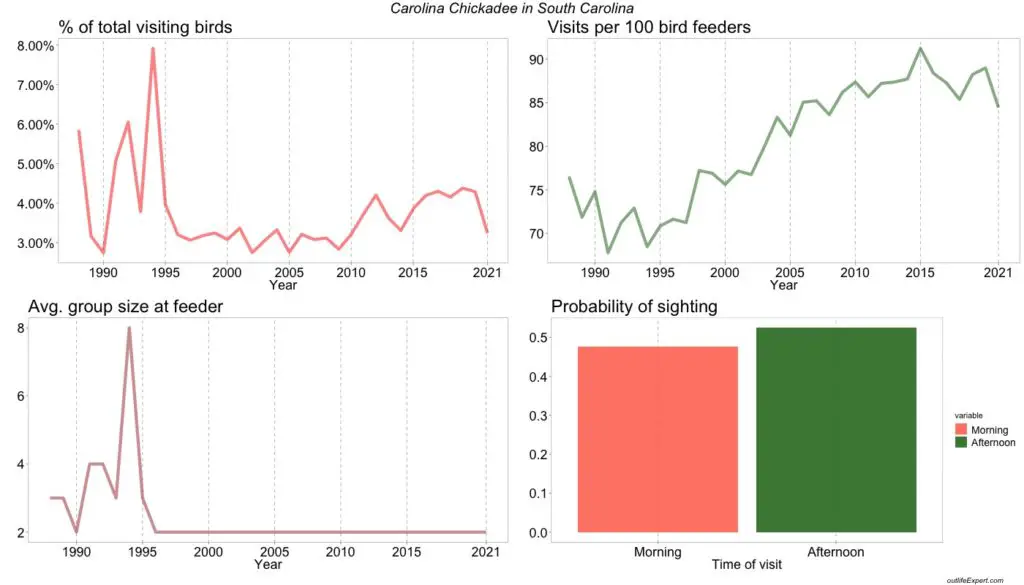
% of total visiting birds: The proportion of the specific bird out of the total number of birds observed bird feeders in this state.
% of total feeders visited: The proportion of feeders (out of all participating feeders in the state each year) where the bird was observed at least once within 2 days.
Avg. group size at feeder: The average number of birds counted simultaneously for each bird feeder observation.
Probability of sighting: The chance of spotting the bird in either morning (before 12 noon) or afternoon (after 12 noon). If both are 0.5 there is an equal chance of spotting the bird in the morning and afternoon.
Carolina Wren (Thryothorus ludovicianus) in South Carolina
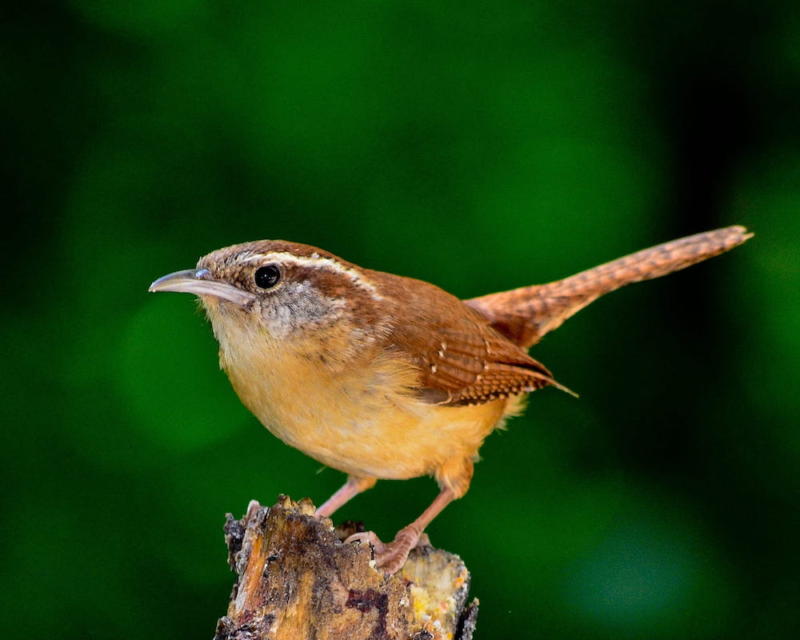
Family: Troglodytidae (Wrens)
Occurrence: Eastern U.S. Southern Canada, Northeast Mexico.
Diet: Omnivorous but mostly insects and smaller animals. Seeds, fruit.
Feeder type preferences:
Feeder food preferences:
- Hulled Sunflower Seeds
- Peanuts
- mealworms
- Suet
Endangered: No.
The Carolina Wren is a small bird in the Wren family (Troglodytidae) and is the state bird of South Carolina. It is a year-round native to the eastern United States and north-eastern Mexico, and can be found in backyards, brushy woods, lowland cypress swamps, clearings, ravines choked with hemlock and rhododendron, overgrown farmland, and brush piles. Carolina Wrens usually spend their time alone or in pairs, they donít flock together like other birds.
While approximately 89% of Carolina Wrens live in the United States, and 10% live in Mexico, a geographically separate population lives in Nicaragua.
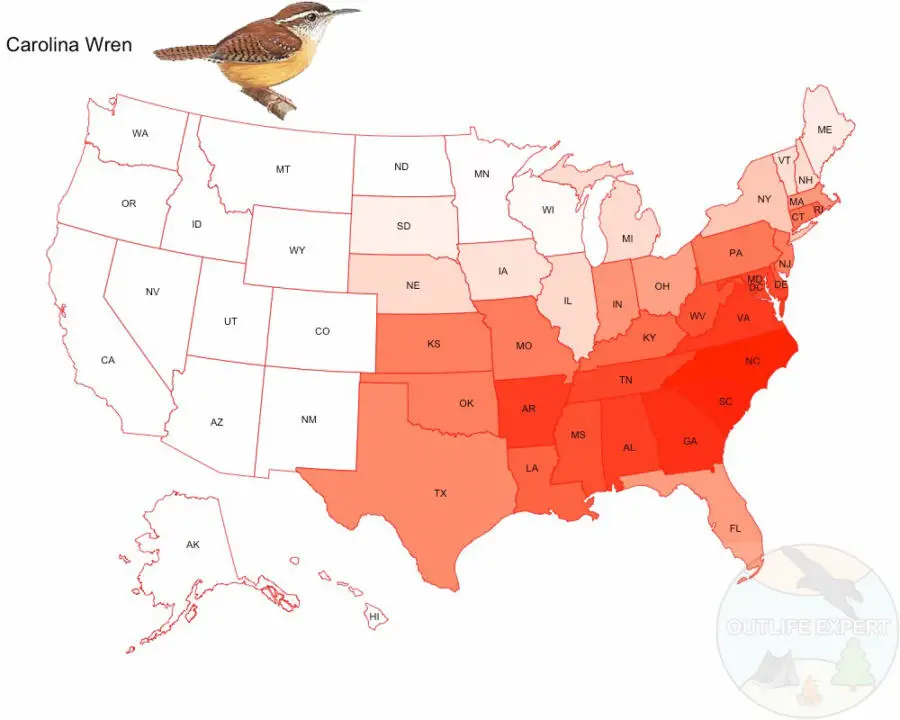
The stronger the red color, the higher the chance that you will see Carolina Wrens in your backyard.
Identification and Regional Differences of Carolina Wrens
Carolina Wrens are described as ëchunkyí, with round bodies and a long tail, a large head, and a very short neck. They are slightly smaller than a sparrow, but bigger than a House Wren. Their dark bill marks this bird as a wren: long, slim and downcurved. Carolina Wrens are more brightly coloured than other wrens, and have a rusty or reddish-brown colouring on top, with cinnamon colouring below, with a white throat and a white stripe above the eye.
There are regional differences in the appearance of the Carolina Wren, with populations in Florida being larger, and stouter. The top feathers are a darker rusty chestnut, and a deeper brown colour below.
Helping the Carolina Wrens through Harsh Winters
As they donít migrate, Carolina Wrens need to survive through the harsh New England winters. The snowy winters cover up much of the wrenís food sources, and severe winters can cause the population to drop dramatically, however they quickly recover. Ironically, the rising winter temperatures have caused the range of the Carolina Wren to move even more northward in the past 100 years.
During these harsh winters, you can help them survive by providing nesting boxes and additional food sources in our backyards, as wrens can rely heavily on feeders to survive. They prefer nest boxes with entrance slots, rather than holes.
Feeding preferences of the Carolina Wren
The Carolina Wren eats insects and spiders from tree trunks, brush, woodpiles, and buildings. But they are also known to eat snakes, frogs, lizards, and even a small amount of plant matter.
The Carolina Wren is the only wren that regularly uses bird feeders as a food source.
They prefer suet feeders, but also enjoy sunflower seeds and are comfortable around a variety of feeder types, and even forage on the ground.
They use their curved bills to help them in foraging for food, by hammering and shaking apart large bugs and turning over decayed vegetation.
Breeding & Nesting of the Carolina Wren
Carolina Wrens nest in open cavities of trees, stumps, and overhangs, usually less than 10 feet off the ground. Males and females work together to build the nests, with one member of the pair collecting materials while the other stays at the nest site. They will often build or start building several nests before the pair makes a final decision on location. The first nest may take more than a week to build, but subsequent nests may be completed in as little as 4 days.
The nest itself is a bulky cup shape, loosely constructed of bark, grasses, leaves, pine needles, hair, feathers, straw, paper, plastic, string, snakeskin, and any other useful materials they can find. The nest has a side entrance with a porch-like extension. The inner bowl of the nest is lined with material by the female.
Wrens are very adaptable however, and will make their nests in a variety of alternative locations, including overturned flowerpots, discarded mailboxes, open tool sheds, a sheltered building nook, and even old boots.
Carolina Wrens form monogamous breeding pairs that often stay together for life. Carolina Wrens may have 1-3 broods per season, from March to October, with 3-7 eggs per brood. The eggs are incubated by the female for 11-17 days. 10-16 days after hatching, the fledglings are ready to leave the nest.
Even after the fledglings have left the nest, it is not uncommon to see family groups foraging and feeding together for a while.
Carolina Wrens Sings in Duets with their partner
Carolina Wrens are known for their year-round singing, often with the male and female singing a ëduetí together. Unlike other wren species in its genus, the male is the primary singer, with the female adding chattering notes.
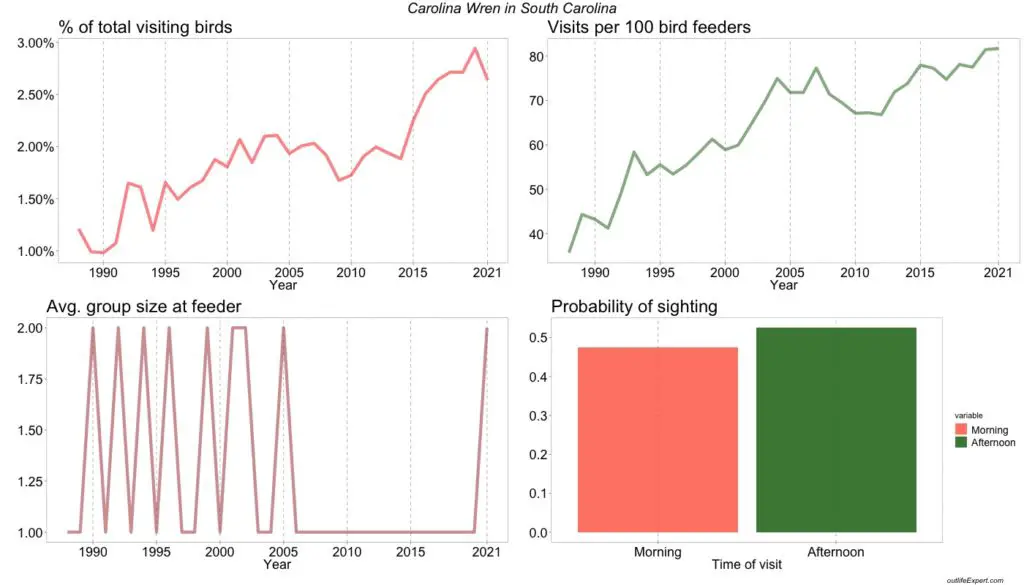
% of total visiting birds: The proportion of the specific bird out of the total number of birds observed bird feeders in this state.
% of total feeders visited: The proportion of feeders (out of all participating feeders in the state each year) where the bird was observed at least once within 2 days.
Avg. group size at feeder: The average number of birds counted simultaneously for each bird feeder observation.
Probability of sighting: The chance of spotting the bird in either morning (before 12 noon) or afternoon (after 12 noon). If both are 0.5 there is an equal chance of spotting the bird in the morning and afternoon.
Tufted Titmouse (Baeolophus bicolor) in South Carolina
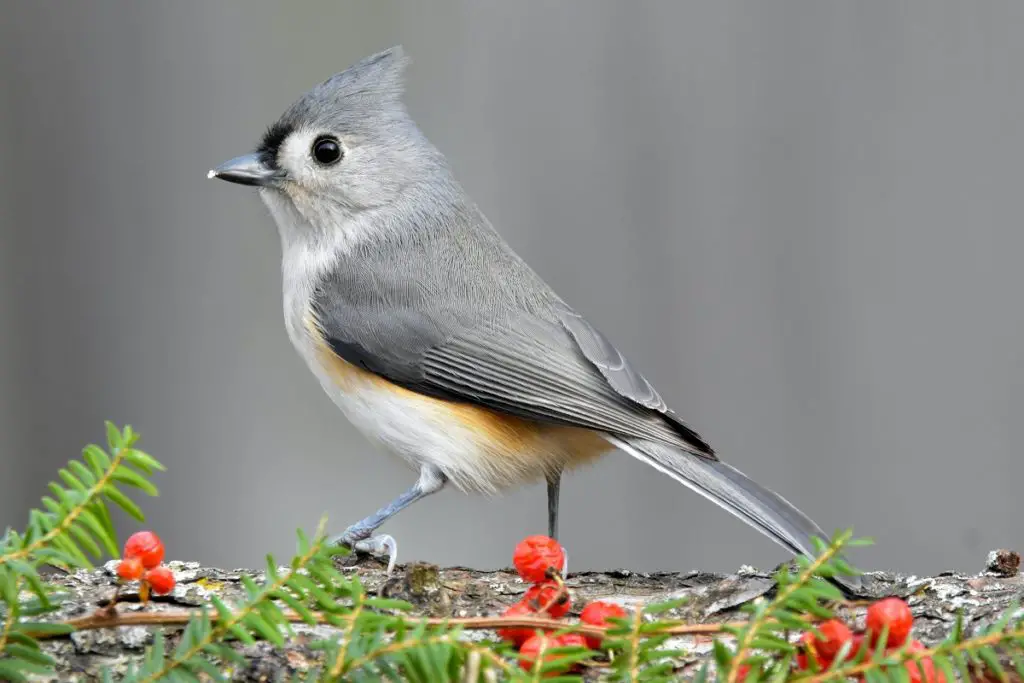
Family: Paridae
Occurrence: Southeastern US.
Natural diet: Insects (mostly summer), fruit, seeds, and nuts in winter.
Feeder type preferences:
Feeder food preferences:
- Black Oil Sunflower Seeds
- Hulled Sunflower Seeds
- Safflower
- Mealworms
- Crushed peanuts
- Whole peanuts
- Suet
Endangered: No.
The tufted titmouse is a small, grey bird of roughly six inches. They are often found in pairs or small flocks, sometimes with other bird species. They can be seen hopping and flitting about around the bird feeder. They will pick a seed from the feeder and fly to a nearby perch to eat it. Other names they are known by is the eastern tufted titmouse, the northern titmouse, or the crested titmouse. Their Latin name captures their two most distinctive features. Baelophus means ìsmall crestedî and bicolor means ìtwo-tonedî.
The tufted titmouse is a common garden bird in the Eastern United States, and the southmost parts of Canada. Originally from the deciduous forests of the Ohio and Mississippi River basins, these birds do well in suburban areas like parks and gardens. Their distribution has expanded over the last few years, supposedly due to warming winters and bird feeders in urban areas.
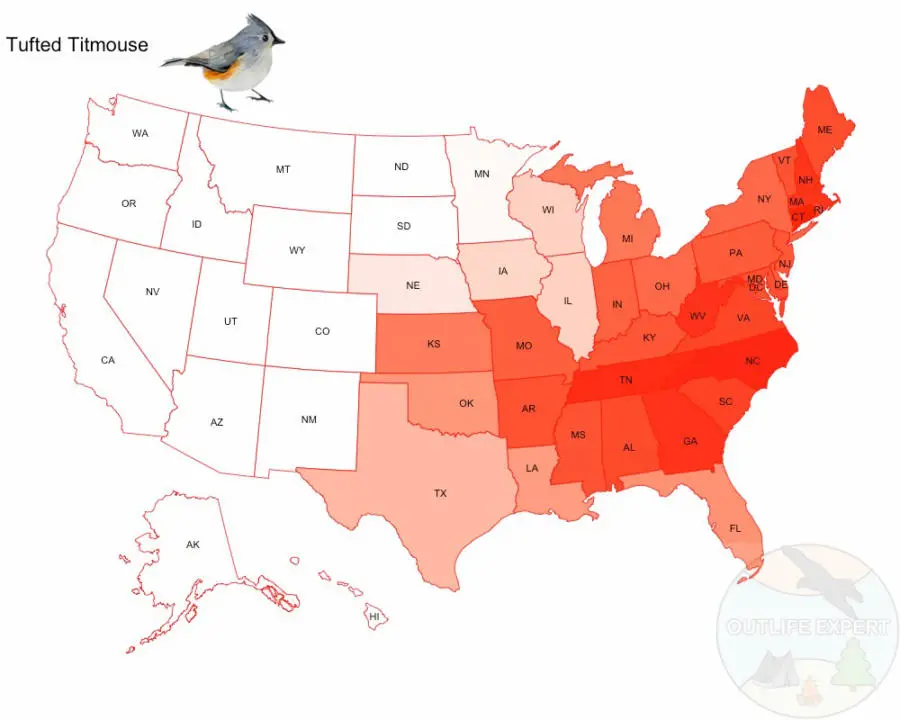
The stronger the red color, the higher the chance that you will see tufted titmouse in your backyard.
They belong to the family Paridae, which contains titmice, chickadees and tits. There are four other titmouse species: the black-crested titmouse, the oak titmouse, the juniper titmouse, and the bridled titmouse. The black-crested titmouse (found in Texas and Mexico) used to be considered a subspecies of the tufted titmouse and they can interbreed. However, they are now considered two separate species.
Identifying the tufted titmouse
The tufted titmouse is mostly grey with white undersides. They have a white face with a black forehead, a distinctive grey crest, and an orange streak across their flanks. Their song sounds like a whistled ìpeter-peter-peterî.
The closely related black-crested titmouse, in contrast, has a white forehead, a black crest, and a ìpeew, peew, peew, peewî song. Hybrids between tufted and black-crested titmice can cause confusion in certain parts of Texas and southwestern Oklahoma. Their forehead can be light orange to dark brown and their crest can be grey or black.
Juvenile tufted titmice have a grey forehead, instead of black, and resemble their all-grey cousins the oak and juniper titmouse. However, their distributions do not overlap. The oak titmouse only occurs along the West Coast of the United States. And the Juniper titmouse occurs in the inland areas of the Southwest.
Biology of the tufted titmouse
Between March and May, the tufted titmouse will use natural cavities, old woodpecker nests, or man-made nest boxes to nest in. They will form a ring of twigs and grasses and line them with soft material such as animal fur. Inside the nest, they will lay five to seven cream-colored eggs with brown spots. Offspring often stay with their parents through the winter and occasionally into the next breeding season to assist in raising the next brood.
A tufted timouseís diet consists of small fruits, seeds and insects. Similar to other parid birds, they hoard food in fall and winter. During these seasons, they will collect food from bird feeders and store them in small holes and crevices.
How to attract the tufted titmouse to your garden
Sunflower seeds are a firm favorite with tufted titmouse. Other food they like include suet, peanuts, berries and mealworms. In your garden, you can plant oak trees, natural berries and sunflowers. A water bath could provide essential drinking water during the winter months when many natural water sources are frozen. During the breeding season, you can put up nest boxes in your garden.
Conservation status and threats of the Tufted Titmouse
Tufted titmice are listed as least concern and their population is steadily increasing. However, they face several threats in urban areas, including predation by cats and collision with glass. If you want to protect the nest of the tufted titmouse, predator guards underneath their nest boxes can protect vulnerable eggs and hatchlings and window stickers on your windows or net curtains can prevent collisions of the tufted titmouse with your house.
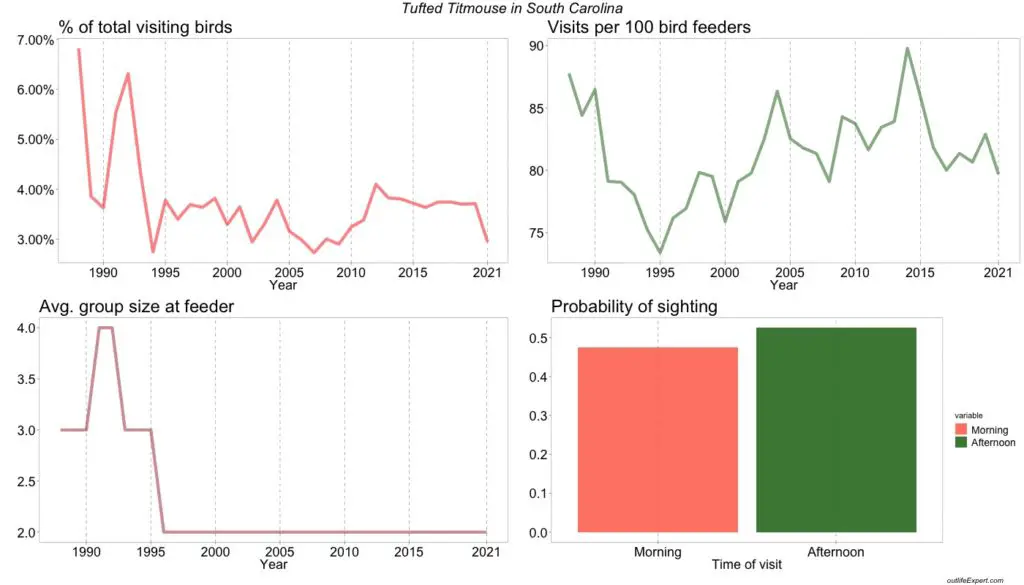
% of total visiting birds: The proportion of the specific bird out of the total number of birds observed bird feeders in this state.
% of total feeders visited: The proportion of feeders (out of all participating feeders in the state each year) where the bird was observed at least once within 2 days.
Avg. group size at feeder: The average number of birds counted simultaneously for each bird feeder observation.
Probability of sighting: The chance of spotting the bird in either morning (before 12 noon) or afternoon (after 12 noon). If both are 0.5 there is an equal chance of spotting the bird in the morning and afternoon.
House Finch (Haemorhous mexicanus) in South Carolina
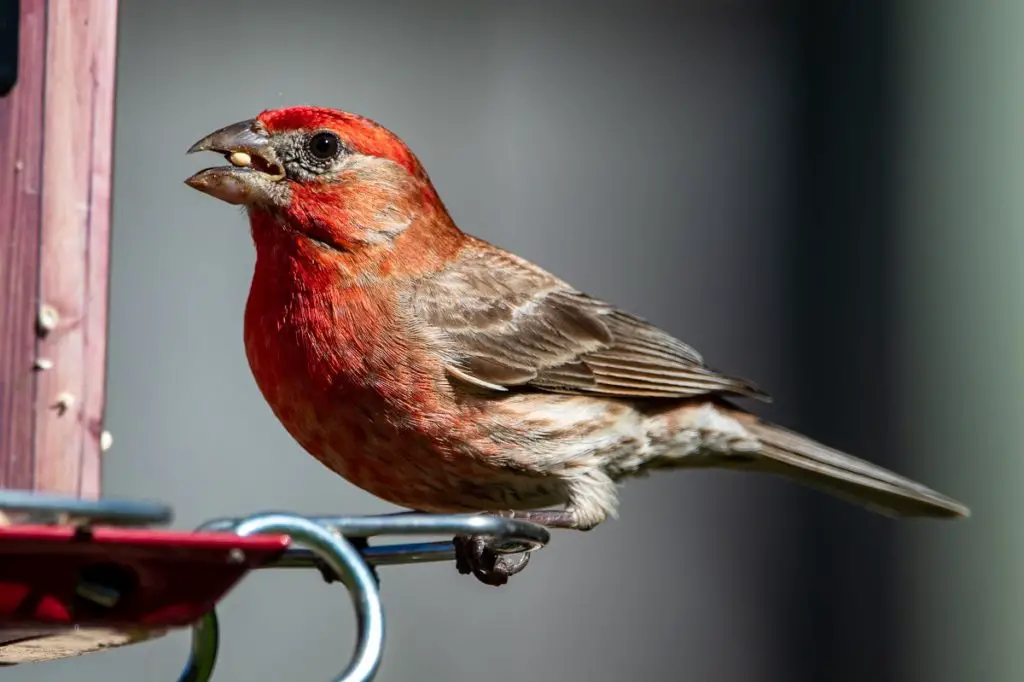
Family: Fringillidae (True finches)
Origin: Southwestern US, and Mexico.
Diet in the wild: Weeds, grains, seeds, fruits, insects.
Feeder type preferences:
Feeder food preferences:
Endangered: No.
The House Finch is a medium sized finch of the Finch (Fringillidae) family. It is native to the west coast of the USA and parts of Mexico but was brought to the East coast by petshop owners selling them as pets in New York (Long Island) in the 1940s. Although it was not legal to import and sell non-native birds, their quickly gained popularity as pets lead to the spread of the House Finch throughout the remaining states of North and East America.

The stronger the red color, the higher the chance that you will see House Finch in your backyard.
From the 1960s the House Finch populations expanded from the Northeast towards the west coast to merge with its indigenous population by year 2000. However, mainly due to the House Finchís unusual susceptibility to parasitic diseases, its numbers declined slightly in the 1990s but have since rebounded to record highs.
Identification and confusions
The House Finch is a common feeder bird but may be confused with the Purple Finch or the Cassinís Finch as especially the females are very similar looking. However, there are some subtle but important differences that can help you to distinguish these finches from each other.
Weighing from 16g to 25g the House Finches tend to be slimmer than Purple Finches (20-30g) as well as the Cassinís Finches (25-35g) and the latter two species have less pronounced markings and longer tails. The colouring of the sister species is more diffuse and covers the head and goes down the back all the way to the tails, whereas the House Finch mostly have markings on the neck and a spot just above its tail.
The House Finch also have a red colour similar to that of the Purple Finch and the Cassinís Finch, but the latter two have a darker purple or burgundy colour rather than the brighter strawberry red of the House Finch.
Another important fact that will make it easier for you to pinpoint the House Finch is that the Cassinís Finch is only present in the south-western parts of the US and less associated with gardens and urban areas. The Cassinís Finch is generally rare at bird feeders and only occurs in the west, so if you live in the east or central parts of the US it is much more likely that the red plumaged Finch at your feeder is a House Finch.
Nesting and mating of the House Finch
During the nesting season from March till August, the female quickly builds a small nest from weeds, grasses, and thin branches. It builds the nest in a matter of days and may place it in trees, hanging vegetation or man-made cavities. Contrary to many other common garden birds, the House Finch does not like to build its nest in man-made bird houses.
The courtship of the House Finch is interesting in that it is sometimes selected based on the type of food it presents to its chosen female on their first date. This ritual may have come about due to the role of the male in feeding the female during the entire egg incubation.
What do House Finches eat and how to attract them?
House finches eat grains, seeds, berries, flower buds and are avid consumers of weeds and smaller insects such as aphids. House Finches are one of the few bird species that prefers to feed their nestlings seeds and other plant material instead of the more protein rich insects. The nestlings prefer dandelion seeds so make sure to keep a few dandelions left in your garden if you want to attract the House Finch.
In Hawaii, the House Finch was introduced in the late 19th century where it quickly became known as the ìPapaya birdî. Due to its large intake of papaya instead of the usual seeds and flower buds it would eat elsewhere, the Hawaiian House Finch often had a more yellowish tone compared to the mainland birds.
House Finches are common and very active at bird feeders, and you may use the following seeds to attract the House Finch to your bird feeder:
- Black oil sunflower seeds
- mustard seeds
- millet
- milo
- Cherries
- Apples
- Apricots
You may consider a tube feeder, a hopper feeder, or a Nyjer Feeder to attract the House Finch, however, it is also seen at nectar feeders, where it competes with humming birds for the sweat sap.
It does like to crack open the sunflower seeds and throw the shell on the ground, so make sure to allow for the empty shells to be tossed of easily. So make sure to consider the location of your feeder as shells will collect underneath.
If you really want to make House Finches happy in your garden, you also need a way for them to drink and shower. Especially if the weather is warm, a House Finch may need to drink up to its own body weight in water each day! A bird bath or a shallow pond could work for that purpose.
If, on the contrary, you do not want the House Finch at your feeder, you should make sure to have only nuts, suet, or animal-based feeder material such as mealworms. You should keep dandelions out of your garden and not have any open water around for them to drink or shower.
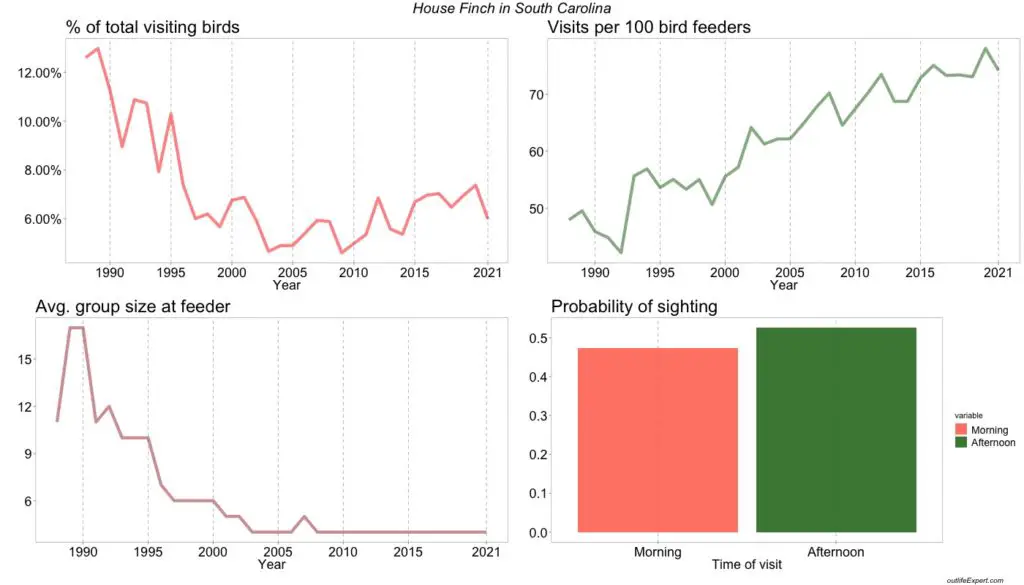
% of total visiting birds: The proportion of the specific bird out of the total number of birds observed bird feeders in this state.
% of total feeders visited: The proportion of feeders (out of all participating feeders in the state each year) where the bird was observed at least once within 2 days.
Avg. group size at feeder: The average number of birds counted simultaneously for each bird feeder observation.
Probability of sighting: The chance of spotting the bird in either morning (before 12 noon) or afternoon (after 12 noon). If both are 0.5 there is an equal chance of spotting the bird in the morning and afternoon.
Looking at prevalence of House Finches at Bird feeders in the United States from 19888 to 2010, we see that the House Finch experienced a drop in the population. This was the case especially eastern and central parts of the US in the early 1990s and was likely due to a high degree of parasite infestations.
The population has later stabilized but the reestablishment has been slow in the United States but is finally on the right track – perhaps because the House Finch collects more in smaller groups (seen from the decreasing flock size in the lower panel). The smaller groups size may have lead to less parasite spread among the birds, but this is not verified.†
Mourning Dove (Zenaida macroura) in South Carolina
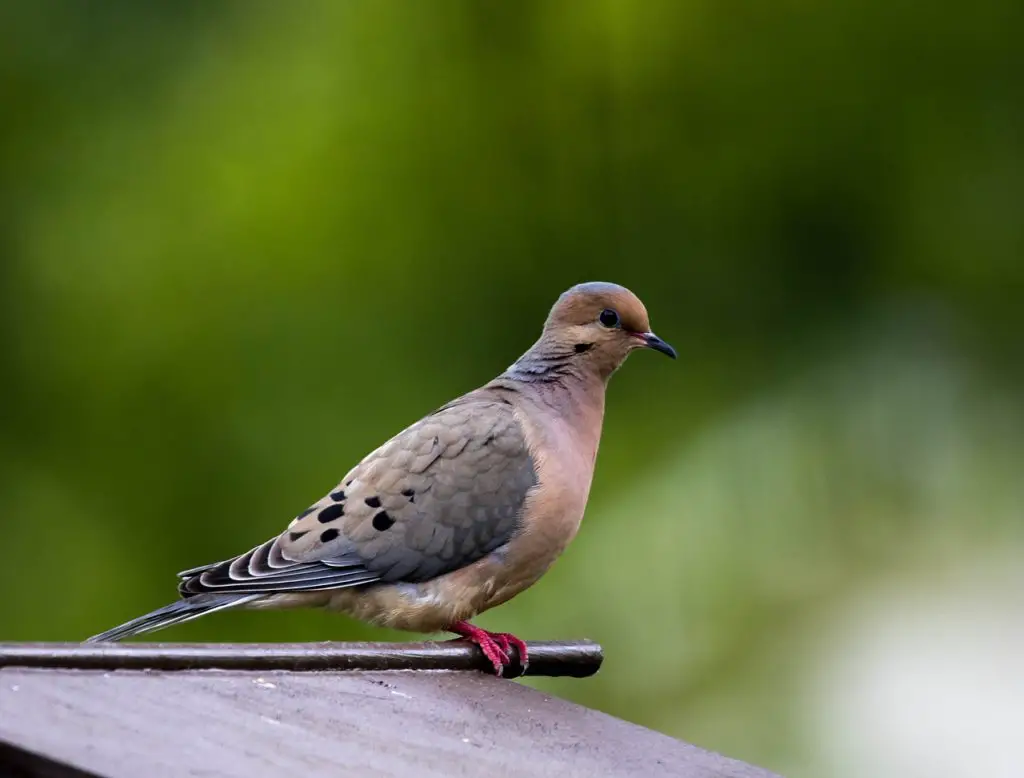
Mourning Dove summary:
Family: Columbidae
Occurrence: Widely across the United States and Canada. Native to Bermuda.
Diet in the wild: Seeds.
Feeder type preferences:
Feeder food preferences:
- Black Oil Sunflower Seeds
- Hulled Sunflower Seeds
- Safflower
- Cracked Corn
- Crushed peanuts
- Millet
- Oats
- Milo
- Nyjer seeds
Endangered: No.
The mourning dove is one of the most abundant land birds in North America, with an estimated population of 350 million. These birds are known and named for their mournful calls, sometimes confused with owls, and a sharp whistling sound made by their wings when taking off.
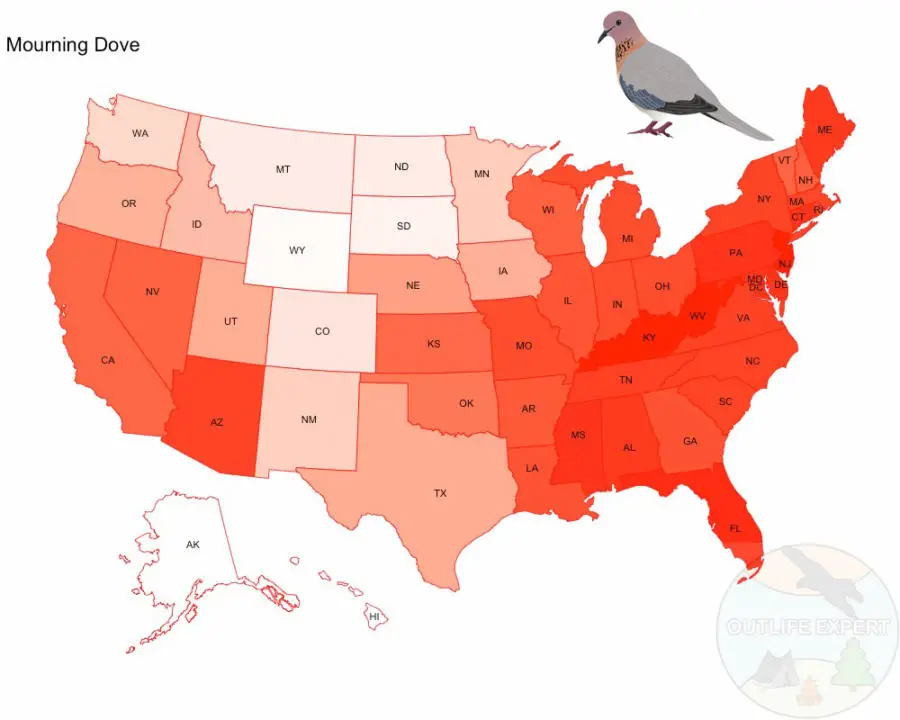
The stronger the red color, the higher the chance that you will see the bird in your backyard.
Identification of the mourning dove
It is a medium sized dove, (similar to a robin in size) has a long, pointed tail, with a plump body, tiny head, and distinctive dark spots on its wings. It is brownish with a tan head, gray wings with black spots, a black bill, pink feet, and a black dot on the side of the face.
Male doves can be distinguished from females, by a purple iridescence on the neck. The mourning dove may get confused with the Eurasian Collared-dove or the white-winged dove. The Mourning Dove species consists of four sub-specifies, two of which can be found in North America: Z. m. carolinensis, found east of the Mississippi River, and Z. m. marginella in the west.
Habitat and migration of the mourning dove
The Mourning dove has a huge range across North America, meaning there are a variety of breeding and migration patterns depending on where they originate.
Mourning doves who live in the northern end of the range (northern USA, southern Canada) migrate as far south as Mexico. While birds in the central and southern US, might migrate only a few hundred km or not migrate at all.
Mourning doves prefer open spaces, like residential suburbs, rural areas, woodland edges, and fields, but avoids thick forested areas. Most people might recognize the mourning dove from perching on telephone poles and eating from their bird feeder.
Nesting & Breeding of the mourning dove
Mourning doves typically nest from February through October and can have anywhere from 1-6 broods (depending on source) with 2 eggs. These birds mate for life, and work together to build the nest, hatch the eggs, and feed their young.
Over a span of 2-4 days, the male will bring the female materials, which she then weaves into a nest approximately 8 inches across. Males sit on the nest during the day, while the females take the night shift. Eggs incubate for 14 days and nestlings stay for 12-15 days.
Mourning doves will build their nests in a variety of locations – they are not picky and are mostly unbothered by humans.
Typical locations include branches of evergreen, vines, cottonwood, orchard tress and mesquite. In the west, nesting on the ground is common nests can also be found in gutters, abandoned equipment, hanging planters, and eaves.
Nests are made from twigs, pine needles, and grass stems and are described as flimsy in construction. They are unlined and donít have much in the way of insulation for the young. It is quite common for mourning doves to reuse their own nests, or reuse the rests of other species of birds.
Diet of the mourning dove and how to attract it
Mourning Doves are primarily foragers, finding seeds on the ground to eat and they may eat up to 20% of their body weight per day.
Seeds make up 99% of its diet, which can include cultivated grains, peanuts, wild grasses, weeds, herbs, berries and even occasionally snails! The mourning dove typically gets its food quickly, stores it in their crop, and digests it later while roosting.
To attract the mourning dove to your own backyard, we recommend scattering seeds on the ground on platform feeders or in a large hopper feeder.
They prefer black and hulled sunflower seeds, safflower, nyjer, cracked corn, peanut hearts, millet, oats and milo. Since this bird spends so much time on the ground, try and keep prowling animals, like cats, inside.
Encourage nest building by planting dense shrubs or evergreen trees, or even put up a nesting cone in advance of the breeding season.
The mourning dove is a popular game bird
These birds are the most hunted game bird in North America, with around 20 million shot each year. The hunting season varies between regions, but can span from September-January. It is one of the only birds whose hunting season overlaps with its nesting season.
Despite the high volume of hunting, there isnít a high level of concern for conservation according to the Continental Concern Score. There are some differing opinions around the degree to which hunting is impacting this species.
Game managers and conservationists monitor the species population numbers to set hunting limits for the mourning dove. However, some sources say that the breeding population cannot keep up their numbers with the pressure from hunting, especially since nesting doves can be hunted.
A unique side effect of hunting is the lead poisoning of mourning doves in hunting heavy areas. Due to being a ground forager, these birds consume spent lead shot, leading to 1/20 doves eating lead.
Despite hunting of the Mourning Dove, it is still very abundant in American backyards and are frequent visitors of bird feeders.
In Maine, although visiting in fewer numbers per visit, the total number of Mourning Doves are stable throughout Maine backyards.
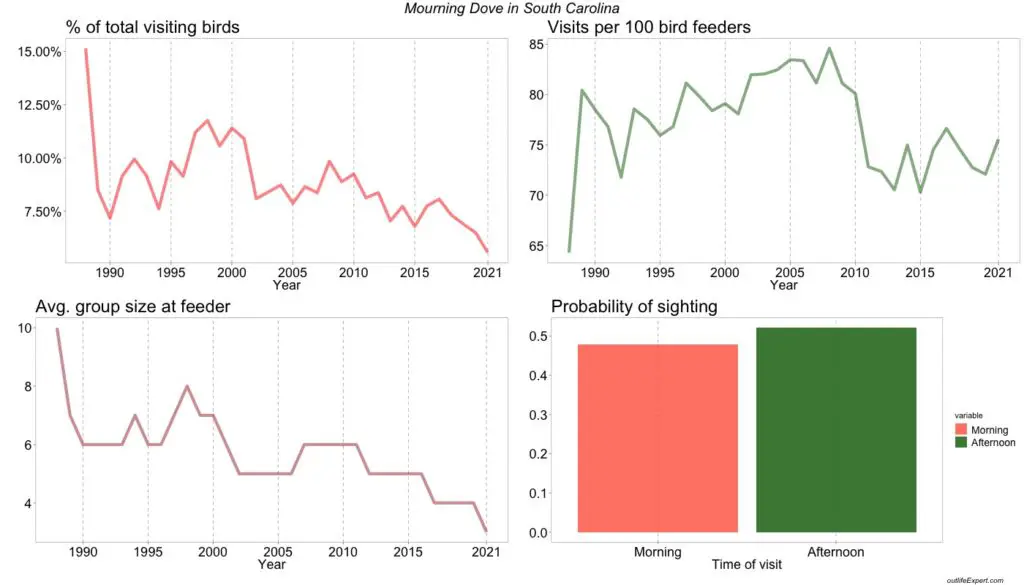
% of total visiting birds: The proportion of the specific bird out of the total number of birds observed bird feeders in this state.
% of total feeders visited: The proportion of feeders (out of all participating feeders in the state each year) where the bird was observed at least once within 2 days.
Avg. group size at feeder: The average number of birds counted simultaneously for each bird feeder observation.
Probability of sighting: The chance of spotting the bird in either morning (before 12 noon) or afternoon (after 12 noon). If both are 0.5 there is an equal chance of spotting the bird in the morning and afternoon.
Downy Woodpecker (Picoides pubescens) in South Carolina
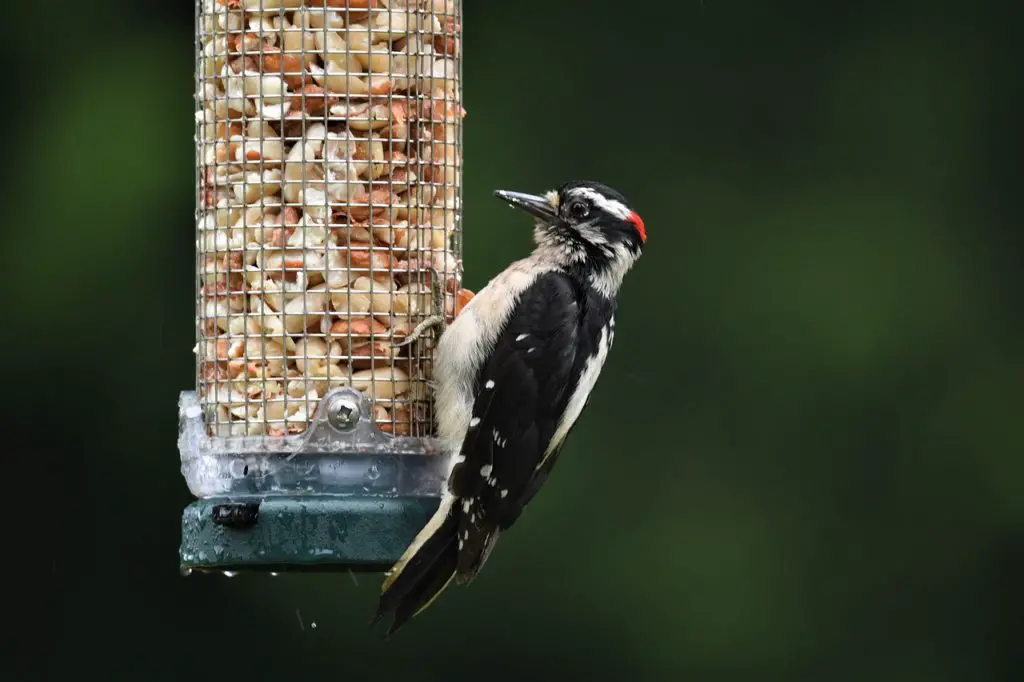
Downy Woodpecker summary:
Family: Picidae (woodpeckers)
Origin: Southeastern US.
Diet in the wild: Insects, seeds, berries.
Feeder type preference:
Feeder food preferences:
- Black Oil Sunflower Seeds
- Hulled Sunflower Seeds
- Safflower
- Peanuts
- Crushed peanuts
- Mealworms
- Suet
Endangered: No.
The Downy Woodpecker is the smallest and most recognizable of the North American woodpeckers in the Picidae family. It is native to North America, spanning a huge range from the East to West Coast, as far north as Alaska and into the southern US. It avoids the southwestern US as the climate is too arid and does generally not migrate much in winter Except in the very northern parts.
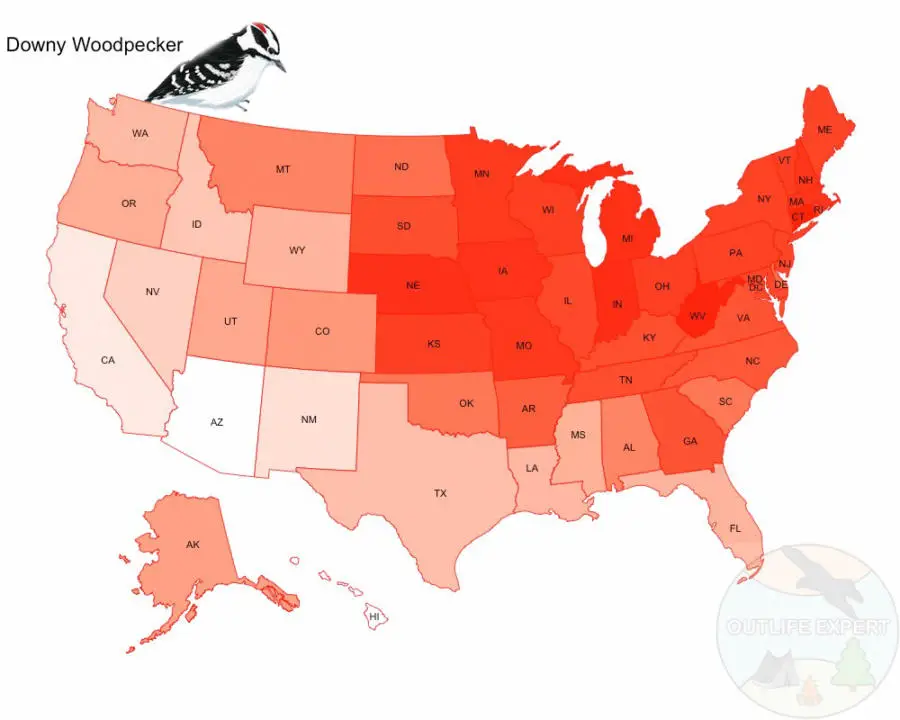
The stronger the red color, the higher the chance that you will see the Downy Woodpecker in your backyard.
Identification & Confusion with the Hairy Woodpecker
The Downy Woodpecker is a small woodpecker, weighing around 30g (1 1/16 oz), with a length of 6-7 inches. Downy Woodpeckers have distinctive plumage, with crisp black-and-white markings. They have a black back with a white stripe up the middle, white belly and white outer tail feathers barred. Males have a distinctive red spot at the rear of the crown, while the femaleís crown is only black. They have a short, stubby bill they use to excavate wood.
The Downy Woodpecker is often mistaken for the Hairy Woodpecker, as it has similar black and white markings, with a white stripe on the back. The Hairy woodpecker is bigger, has a much longer bill that is nearly half as along as its head, and only have white outer tail feathers.
Unique Behaviours of the Downy Woodpecker
While Downy Woodpeckers are not songbirds, they do have a unique way of making noise with their beaks. They will drum their beaks against wood or metal to create the loud drumming sound we are familiar with. A common misconception is that the drumming is related to the Downy Woodpeckersí feeding habits or excavation, but they actually make very little noise while foraging or excavating. Downy Woodpeckers drum to find mates and to signal to other woodpeckers that this is their territory.
The Downy Woodpecker will typically stay in the same area after breeding, but will range through different habitats, like suburbs and gardens, looking for food.
Downey woodpeckers participate in some unique behaviours in the winter season. They are the only North American woodpecker that uses the reedbed as a winter habitat. They are also frequently found in mixed-species flocks, alongside chickadees and nuthatches – especially at backyard bird feeders! While Downy Woodpeckers are usually solitary birds, flocking in the winter allows them to spend less time watching for predators, as the flock provides safety in numbers and better opportunities for foraging.
Downy Woodpeckers Nesting and favorite habitats
The Downy Woodpecker can breed in a variety of habitats, including deciduous, mixed deciduous-coniferous forests, suburban woodlands, parks, and areas near rivers. Downy Woodpeckers make their nest in dead trees or branches, which both males and females excavate using their bills, to create a nest hole. They can also nest in man-made objects, such as fenceposts, a nest box mounted on a tree or a pole, or even inside the walls of buildings.
Downy Woodpeckers will often choose deciduous trees or wood infected with fungus, as this softens the wood and makes excavating easier. The entrance holes are round and 1-1.5 inches across, but widens near the bottom to 6-12 inches to fit the eggs and the incubating bird. Excavating the nest takes 1-3 weeks, and they do not add any material to their nest once excavated.
The nesting season runs from May-July, where they may have 1 brood with 3-8 eggs. Both male and female will incubate the egg for about 12 days and fledglings leave the nest after 18-25 days.
What do Downy Woodpeckers eat?
Downy Woodpeckers are foragers, primarily eating insects from the surfaces and crevices of both dead and live trees, including food too small for larger woodpeckers. This includes spiders, ants, caterpillars, beetle larvae that live inside wood, and tree bark. The Downey Woodpecker is a very helpful bird, as it also eats many pests and invasive species, like tent caterpillars, bark beetles, apple borers, and corn earworms. They are also known to eat fruits, seeds, and vegetable matter depending on the seasonal availability.
During winter, the male woodpecker dominates the best foraging spots, like small branches and weed stems, actively keeping females out of these areas. The females are left to forage on tree trunks and larger branches, which are less food dense. A research study demonstrated that when the male Downy Woodpecker is removed, the females move to foraging on the smaller branches.
If you want to attract the Downy Woodpecker, they prefer pick on suet blocks to mimic their natural feeding behaviour. They also like black oil and hulled sunflower seeds, safflower, peanuts, peanut hearts, chunky peanut butter, and mealworms. You can use a suet cage, or feeders like large or small hopper and platform feeders.
You can also find the woodpecker drinking out of oriole and hummingbird feeders, but at feeders the Downy Woodpecker will give way to its larger family member, and lookalike, the Hairy Woodpecker.
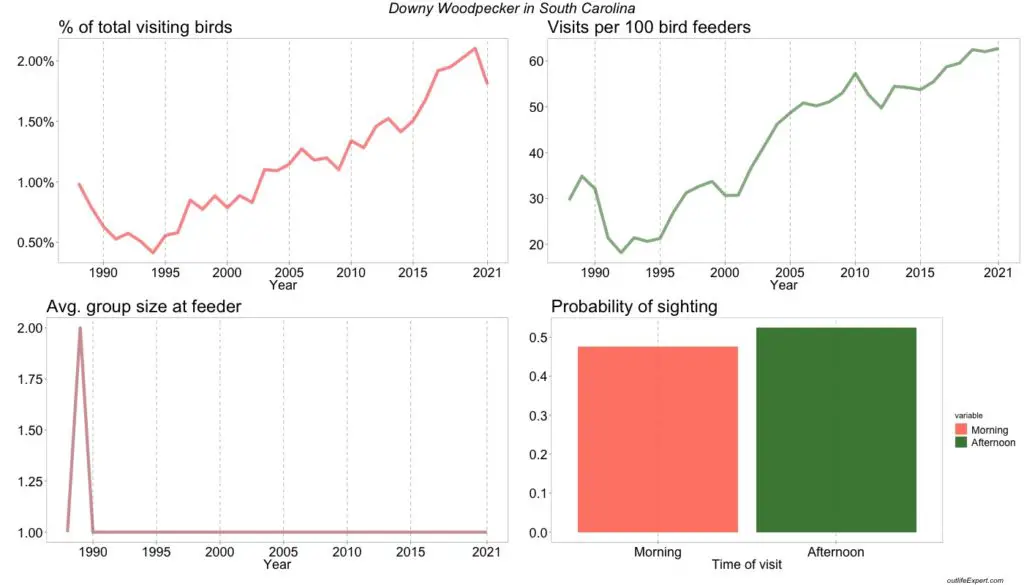
% of total visiting birds: The proportion of the specific bird out of the total number of birds observed bird feeders in this state.
% of total feeders visited: The proportion of feeders (out of all participating feeders in the state each year) where the bird was observed at least once within 2 days.
Avg. group size at feeder: The average number of birds counted simultaneously for each bird feeder observation.
Probability of sighting: The chance of spotting the bird in either morning (before 12 noon) or afternoon (after 12 noon). If both are 0.5 there is an equal chance of spotting the bird in the morning and afternoon.
Red-bellied Woodpecker (Melanerpes carolinus) in South Carolina
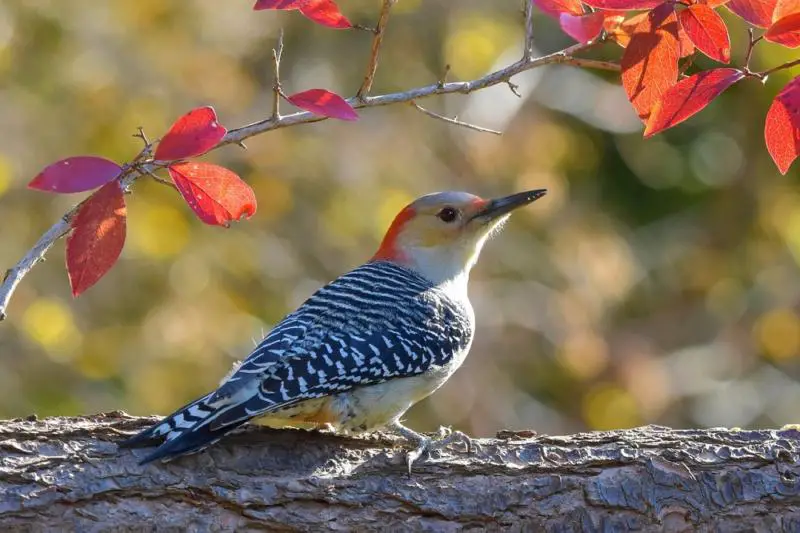
Family: Picidae (Woodpeckers)
Occurrence: Eastern and Southwestern North America.
Natural diet: Insects, nuts and fruit.
Feeder type preferences:
- Suet Cage
- Large hopper feeder
- Nectar feeder
- Platform feeder
Feeder food preferences:
- Black Oil Sunflower Seeds
- Hulled Sunflower Seeds
- Safflower
- Mealworms
- Crushed peanuts
- Cracked corn
- Whole peanuts
- Fruits
- Nectar
- Suet
Endangered: No.
This medium-sized woodpecker is very common in the eastern half of the United States ñ stretching from Canada in the north to Florida in the south and is particularly numerous in the southern states. In the last century, its breeding range has increased. The English naturalist Mark Catesby described this woodpecker in the 1730s and used the name Red-bellied woodpecker.
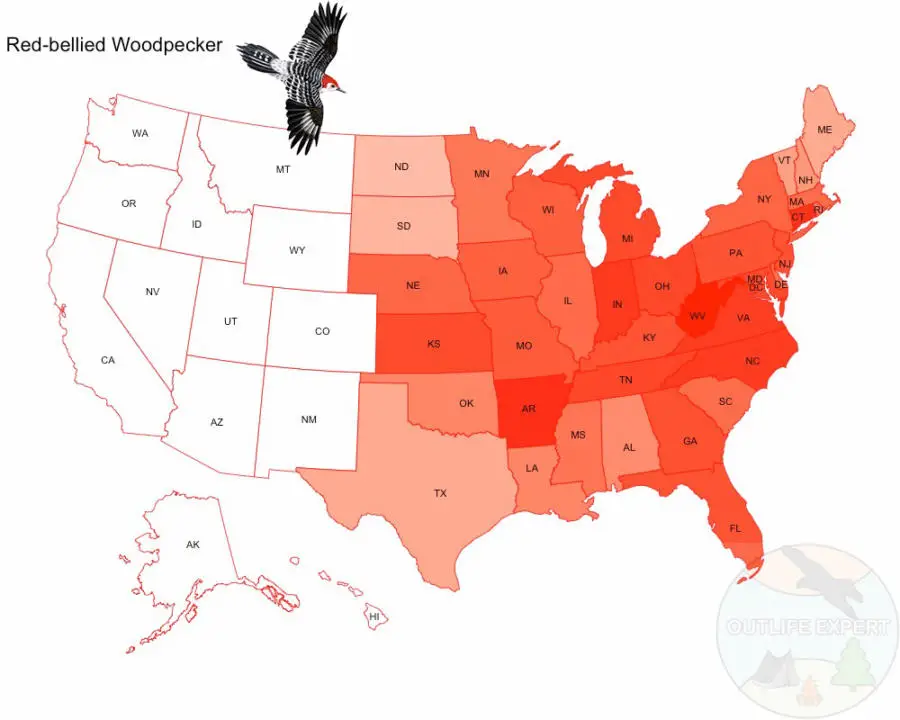
The stronger the red color, the higher the chance that you will see the Red-bellied Woodpecker in your backyard.
How and where to spot the Red-bellied Woodpecker
Like all woodpeckers, the Red-bellied woodpecker can often be spotted on tree trunks. With two forward facing and two backward facing toes for extra grip, this woodpecker can be seen speedily moving up and down tree trunk.
Despite its name, the feathers on its belly are only tinted with crimson red and this can only be seen in certain light. The male has a bright red cap that stretches from its forehead to the back of its neck, whereas the female only has red on the back of her neck and base of her bill. Both sexes have black and white bars on their back and wings, stout tail feathers to help them balance on tree trunks, sharp black bills and gray legs and feet.
The Red-bellied Woodpecker can be confused with the Gilas and Golden-footed Woodpecker as well as the Ladder-backed Woodpecker.
This species of woodpecker loves to chatter and both sexes are vocal and even noisy all year through. Their call sounds like a melodic ëchurr churrí. The males also drum to communicate and urban ones can be even heard drumming on roofs and metal gutters.
Habitat and mating of the Red-bellied Woodpecker
The Red-bellied Woodpecker can be found in mixed woodlands, groves and orchards. It loves a mixture of deciduous and evergreens and prefers medium ñ large trees. This woodpecker is particularly fond of oak trees and hickory.
The Red-bellied Woodpecker nests in old cavities and tree trunks and live softer wooded trees. has a single brood in the north and two broods if they live in the south. They have 4- 6 eggs and the parents jointly take care of their young. They defend their eggs and young from other woodpeckers, squirrels and snakes.
The eggs are incubated for 12-14 days and both parents take turns to sit on the eggs. The young have a high-pitched sound and leave the nest 22-27 days after birth. Even once they have left, if they see their parents, they will often call to them for food. Red-bellied Woodpeckers are very vigilant parents and have to be because of predators such as starlings, snakes and even other woodpeckers who want to harm their young.
What does the Red-bellied Woodpecker eat and how do I attract it?
This species of woodpecker uses its sharp bill for pecking at the bark, rather than drilling holes in it. The reason is that it is trying to disturb bugs and insects living under the bark and it has a long tongue to help it retrieve insects successfully. This species of woodpecker also keeps stores of food which it hides under tree bark and in deep cracks in tree trunks.
The Red-bellied Woodpecker can certainly be attracted to bird feeders with one particular food that they adore ñ suet! As well as suet they also like sunflower seeds, peanuts, fruit and sugar water.
A hundred years ago, the numbers of Red-bellied Woodpecker seemed to be falling, but in recent years the numbers have stabilized and started to increase slightly ñ probably because this species has been able to adapt so successfully to urban life. They are not endangered but because their favorite habitat is mature woodland, which is being cleared at an alarming rate, their numbers could start to fall again.
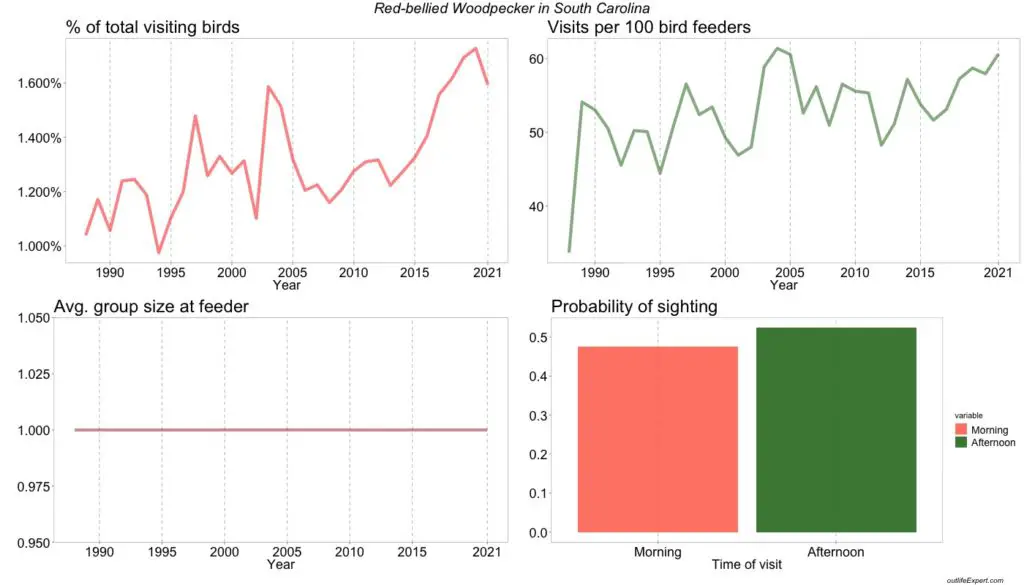
% of total visiting birds: The proportion of the specific bird out of the total number of birds observed bird feeders in this state.
% of total feeders visited: The proportion of feeders (out of all participating feeders in the state each year) where the bird was observed at least once within 2 days.
Avg. group size at feeder: The average number of birds counted simultaneously for each bird feeder observation.
Probability of sighting: The chance of spotting the bird in either morning (before 12 noon) or afternoon (after 12 noon). If both are 0.5 there is an equal chance of spotting the bird in the morning and afternoon.
American Goldfinch (Spinus tristis) in South Carolina
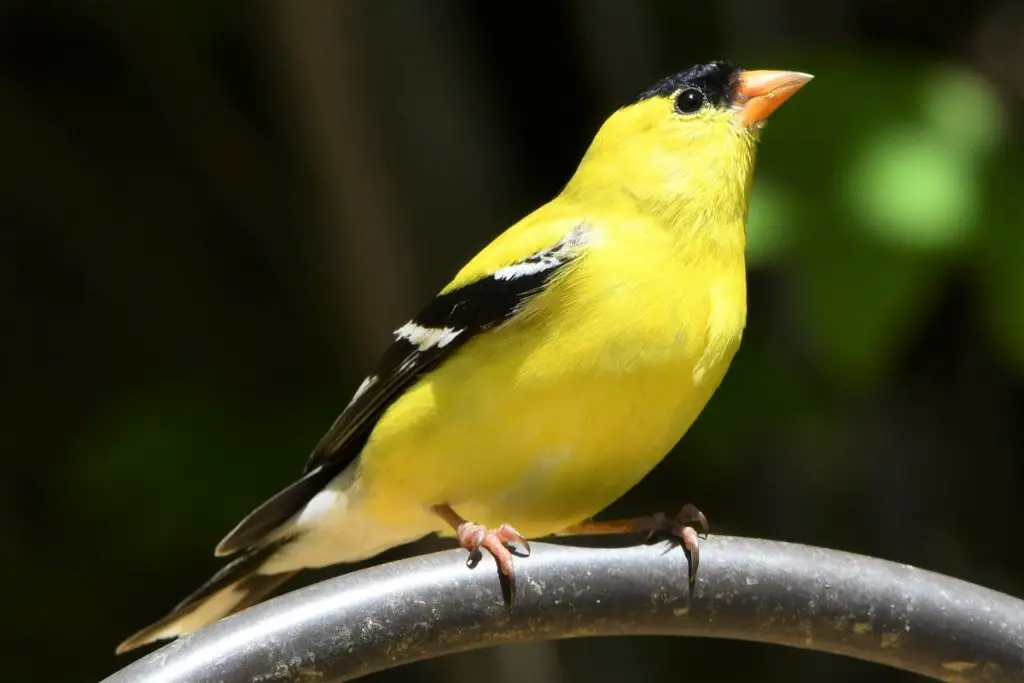
American Goldfinch summary:
Family: Fringillidae
Occurrence: Southern Canada to California in the summer. Also Florida and Mexico in winter.
Diet in the wild: Seeds, insects.
Feeder type preferences:
- Large tube feeder
- Small tube feeder
- Ground feeder
- Large hopper feeder
- Small hopper feeder
- Platform feeder
Feeder food preferences:
- Black Oil Sunflower Seeds
- Hulled Sunflower Seeds
- Nyjer (Thistle) seeds
Endangered: No.
The American goldfinch is a small garden bird commonly found in large flocks throughout the US, southern Canada, and central Mexico. As short-distance migratory birds, they move south during the winter to escape the cold.
During summer they are found from southern Canada to California and North Carolina. During winter, they can be found from Washington to Nova Scotia south into central Mexico. Their natural habitat is open meadows, but they often flock towards bird feeders in suburban areas. They are the official state bird of three US states: Iowa, New Jersey, and Washington.
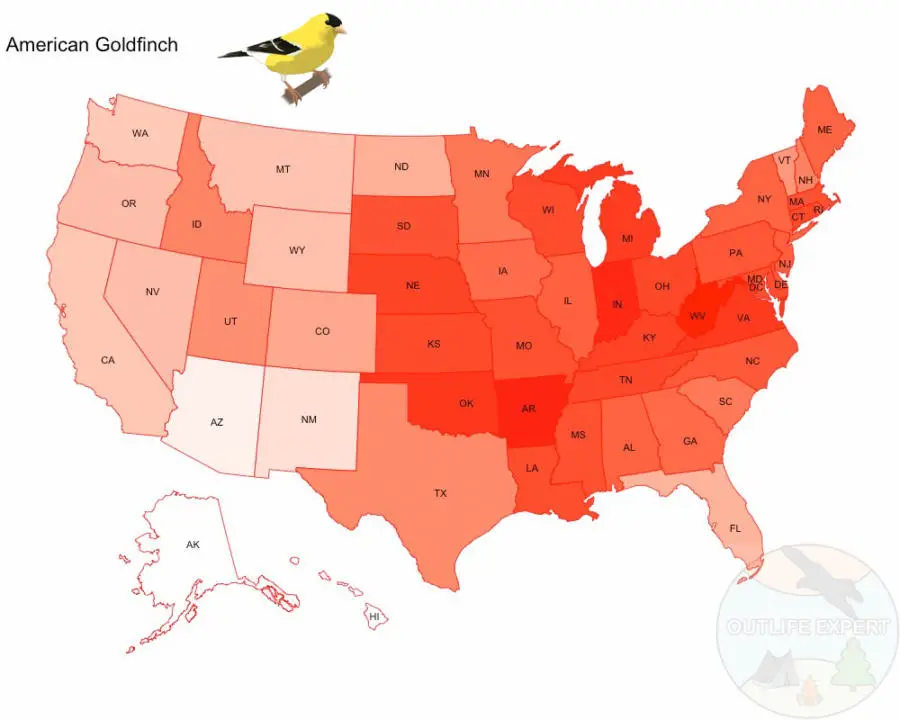
The stronger the red color, the higher the chance that you will see the American goldfinch in your backyard.
The American goldfinch belongs to the Fringillidae (finch) family. There are four subspecies: the eastern goldfinch, the pale goldfinch, the northwestern goldfinch, and the willow goldfinch. Other closely related species include the lesser goldfinch, Lawrenceís goldfinch, and the siskins. Despite the similar sounding name, they are not related to the European goldfinch.
Identifying the American goldfinch
The American goldfinch is a 4 to 6-inch, brown to yellow bird with a white undertail. Their wings and tail are black with white markings. In summer, the male is easily distinguishable with his bright yellow plumage and black cap. The female has a pale-yellow underside in the summer months with an olive-colored head and back. In winter, both males and females are olive-brown with a yellowish head. Juveniles are a dull brown with pale yellow undersides. Their call is a chirpy ìtsee-tsi-tsi-tsitî.
Subspecies can be distinguished by their distribution and small variations in coloration and size. The eastern goldfinch is the most common and most eastern subspecies. They occur from Colorado eastwards from southern Canada to central Mexico.
The slightly larger pale goldfinch, as its name suggests, has a paler body, stronger white markings, and a larger black cap in the male. They have a more western range stretching from British Columbia to western Ontario south to Mexico.
The northwestern goldfinch is darker and smaller compared to the other subspecies. They occur along the coastal slope of the Cascade Mountains from southern British Columbia to central California. The willow goldfinch has a browner winter plumage, and in summer, males have a smaller black cap. They are found to the west of the Sierra Nevada range in California southwards into Baja California.
The male lesser goldfinch could be confused with the male American goldfinch but their cheeks and back are olive to black instead of yellow and the black crown of the male covers its entire head. In both males and females, the lesser goldfinch has a yellow undertail, instead of white. The Lawrenceís goldfinch male has a black face and yellow breast, but the rest of its body is grey. Females of Lawrenceís goldfinch have a grey head and back, whereas the American goldfinch has a yellow head and olive back.
Breeding and feeding of Goldfinches
The American goldfinchís diet consists entirely of seeds. Their breeding season starts in June, when seeds are in greatest supply. Monogamous pairs nest in trees or shrubs. Their nest is an open cup of three inches, woven from plant fibers, bound by spiderwebs and caterpillar silk, and lined with plant down. They will lay four to six eggs, each less than an inch long, pale bluish white, with occasional brown spots.
Attracting the American goldfinch to your backyard
To attract the American goldfinch, you can put out various seeds (especially sunflower and nyjer seeds), and beet greens. Use a feeder designed for smaller birds, because large birds at the feeder could discourage the American goldfinch. During the breeding season, you can put out 100% cotton for them as nesting material. Plant indigenous grasses, sunflowers, thistles, dandelions, coneflowers, milkweed, zinnias, and large trees in your garden. A bird bath or water feature would provide an additional attraction.
Yellow birds in South Carolina
Did you spot a yellow bird in your backyard? There are several different yellow bird species, but not all of them are equally common!
Seeing a bright yellow bird in your backyard can be an eye-catching sight. Luckily, yellow birds are not rare in North America, but there are clearly some species that are more common than others. If you see a yellow bird though, it is most likely a Goldfinch or a Warbler!
In South Carolina , the American Goldfinch is the only really bright yellow bird and is the yellow bird you are most likely to see in your backyard. Other yellow birds that you may have a chance of luring to your bird feeder in South Carolina at a fairly high rate are the Yellow-rumped Warbler, the Orange-crowned Warbler, the Pine Warbler, and the somewhat yellow Pine Siskin and Yellow-bellied Sapsucker.
Is the american goldfinch endangered?
The American goldfinch is listed as least concern since its population is generally increasing across the United States. However, climate change could cause southern contractions in their distribution with local extinctions in various states, due to the increased risks of heatwaves and heavy rainfall endangering their eggs and chicks.
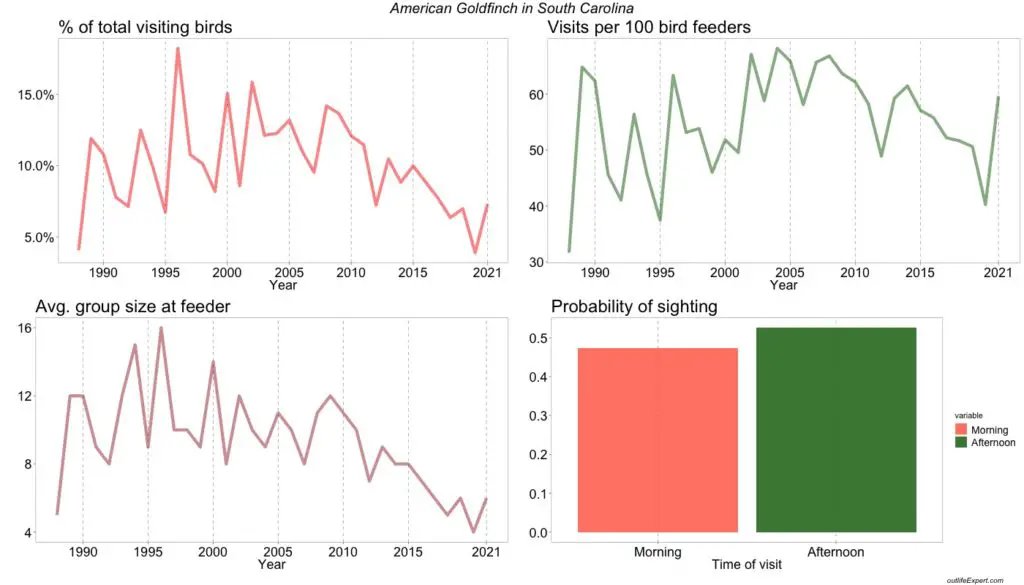
% of total visiting birds: The proportion of the specific bird out of the total number of birds observed bird feeders in this state.
% of total feeders visited: The proportion of feeders (out of all participating feeders in the state each year) where the bird was observed at least once within 2 days.
Avg. group size at feeder: The average number of birds counted simultaneously for each bird feeder observation.
Probability of sighting: The chance of spotting the bird in either morning (before 12 noon) or afternoon (after 12 noon). If both are 0.5 there is an equal chance of spotting the bird in the morning and afternoon.
Blue Jay (Cyanocitta cristata) in South Carolina
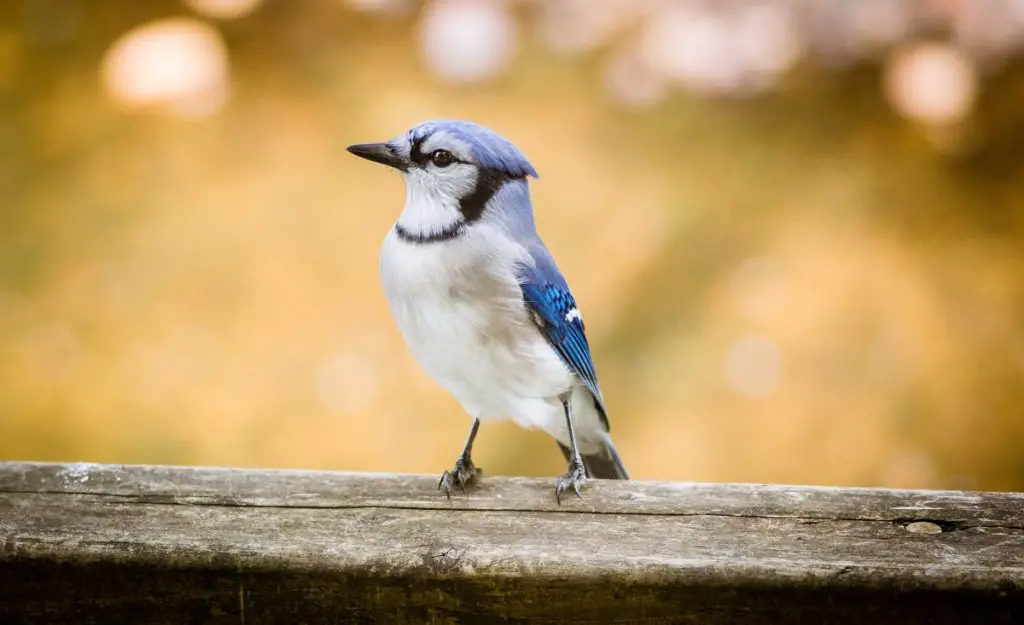
Family: Corvidae
Occurrence: Eastern United States. Southern Canada.
Diet in the wild: Acorns, seeds, berries, insects, small animals.
Feeder type preferences:
- Ground feeder
- Large tube feeder
- Suet Cage
Feeder food preferences:
- Suet
- Black Oil Sunflower Seeds
- Hulled Sunflower Seeds
- Safflower
- Mealworms
- Fruit
- Whole peanuts
- Crushed peanuts
- Nyjer seeds
- Milo
- Millet
Endangered: No.
The blue jay is a conspicuous garden bird throughout southern Canada, eastern and central United States. Cyanocitta, the first part of its Latin name, is derived from the Greek words ìkyaneosî, which means blue, and ìkittaî, which means chattering bird. Cristata, the last part of its name in Latin, is derived from the Latin word for ìcrestedî.
In the northern regions, some will migrate south for the winter, depending on weather conditions and food abundance.
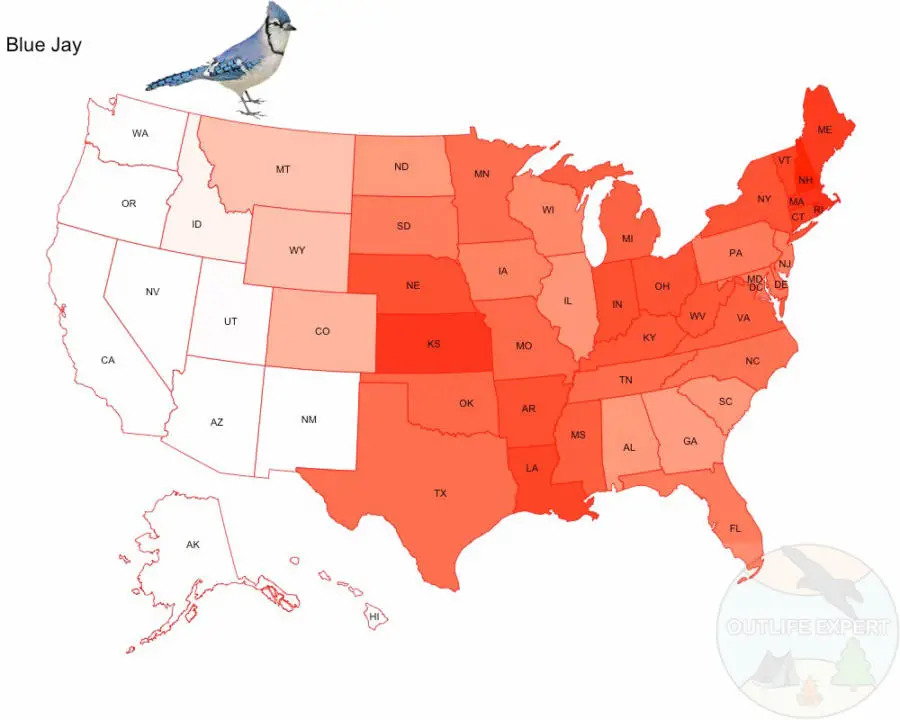
The stronger the red color, the higher the chance that you will see the Blue Jays in your backyard.
Blue jays belong to the Corvidae (crow) family and are related to crows, magpies, and nutcrackers. There are four subspecies of blue jays: the northern blue jay, the coastal blue jay, the Florida blue jay, and the interior blue jay. Their closest relative is Stellerís jay, and hybrids have been reported where their distributions overlap.
They are the official mascot of the Toronto Blue Jays baseball team, John Hopkins University (Maryland), Elmhurst University (South Carolina), and Creighton University (Nebraska). They are the provincial bird of Prince Edward Island in Canada. They also feature in Cartoon Networkís Regular Show as the cartoon character Mordecai.
Identifying the blue jay
The blue jay is 9 to 12 inches, blue with a white face and underparts. They have a characteristic blue crest, which they raise when agitated. Their black collar extents up from their neck to frame the back of their crest.
Their wings and tail have black and white barring. The black markings on their face and neck vary between individuals. They have several calls and sounds, including a loud ìjay! jay!î. They can mimic the calls of raptors to scare away other birds from food sources.
Of the four subspecies, the northern blue jay is the largest with the palest blue color. They occur in Canada and the northern United States.
The coastal blue jay is vivid blue and is found along the coast from North Carolina to Texas, except for south Florida, where the Florida blue jay is found. The Florida blue jay is smaller and paler than the coastal blue jay. The interior blue jay is found in inland USA and is dark blue with a contrasting white underside.
The closely related Stellerís jay has a black crest and head, their underparts are blue instead of white, and they lack the barring on their wings.
Other birds that can be confused with the blue jay include the Florida scrub-jay, Woodhouseís scrub-jay, and the California scrub-jay.
However, these birds have no crest, no barring on their wings, no collar around their neck, and grey faces, instead of white.
Is the Blue Jay a woodpecker?
People often ask me what the blue woodpecker at their bird feeder is called. This happens to stem from a common misconception, that the Blue Jay is a woodpecker.
In short: there are no blue woodpeckers and the Blue Jay is not a woodpecker. In fact, it is more closely related to crows than it is to woodpeckers!
However, the misconception is understandable, as Blue Jays has the size of a small woodpeckers and may often be present near and interact with woodpeckers at the bird feeder.
The Blue Jay has a physiology and a strong bill that may resemble that of woodpeckers, and may be seen pecking all sorts of objects such as windows or even the paint of a house! This is usually not because it is looking for insects inside the wood, such as woodpeckers do, but mostly a result of the aggressive nature of Blue Jays.
How to tell the difference between the male and female blue jays?
Biology
Their natural habitat is deciduous and coniferous forests, but they are well adapted to suburban areas. They will eat almost anything, including seeds, nuts, fruits, insects, and occasionally the eggs and chicks of other birds, small rodents, and frogs.
They are aggressively territorial towards other birds, predators, and humans. Blue jays sometimes get mobbed by other birds because blue jays are known to raid nests. On the other hand, birds in the same area can benefit from the loud alarm call of the blue jays and their ability to chase away predators.
Their breeding season is from March to May. Their nest is an open cup between tree branches. Sometimes they steal the nests of other songbirds, such as the American robin. They will lay two to seven blueish-brown eggs with brown spots.
How to attract the blue jay to your garden
In your birdfeeder, you can place peanuts, sunflowers, cracked corn, millet, suet, and mealworms for the blue jay. Large trees like oak and beech can provide shelter, food, and potential nesting sites. Crabapple, red mulberry, and wild cherry will attract blue jays with their fruit. You can provide a large bird bath for them to wash in and drink from in your garden.
Conservation status and threats
The blue jay is listed as least concern and their numbers are stable. Recently, their population has been declining along the Atlantic coast, and increasing in the northern parts of its range in southern Canada. Climate change might lead to range retractions in its northwestern distribution. Their main threats are spring heat waves endangering their chicks and urbanization destroying suitable habitat.
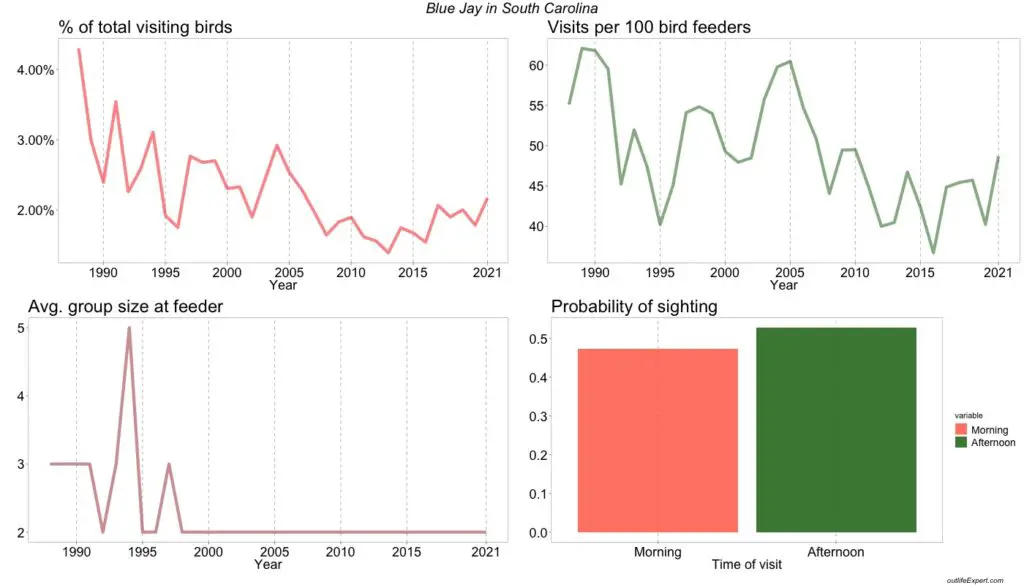
% of total visiting birds: The proportion of the specific bird out of the total number of birds observed bird feeders in this state.
% of total feeders visited: The proportion of feeders (out of all participating feeders in the state each year) where the bird was observed at least once within 2 days.
Avg. group size at feeder: The average number of birds counted simultaneously for each bird feeder observation.
Probability of sighting: The chance of spotting the bird in either morning (before 12 noon) or afternoon (after 12 noon). If both are 0.5 there is an equal chance of spotting the bird in the morning and afternoon.
White-throated Sparrow (Zonotrichia albicollis) in South Carolina
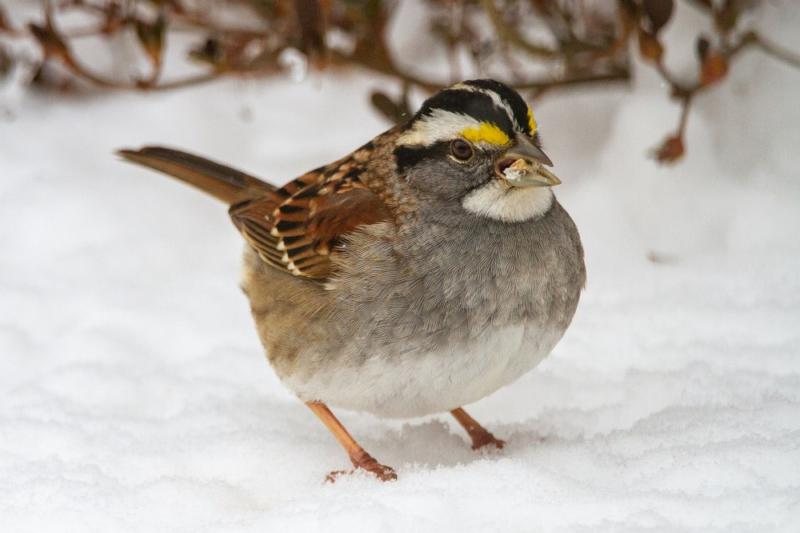
Family: Passeridae (Old world sparrows)
Origin: Northeastern US, Canada.
Diet: Weeds, grains, seeds, insects.
Feeder type preferences:
- Platform feeder
- Ground feeder
Feeder food preferences:
Endangered: No.
Like the Dark-eyed Junco, the White-throated Sparrow is a member of the New World Sparrows family (Passerellidae.). The White-throated Sparrow is an abundant migratory bird, with an estimated population of 140 million.
They are widespread in forests across North America. Their range includes Canada, the northeastern US, and the northern Midwest. White-throated Sparrows sing yearlong, also throughout the long northern winters and sometimes even at night.
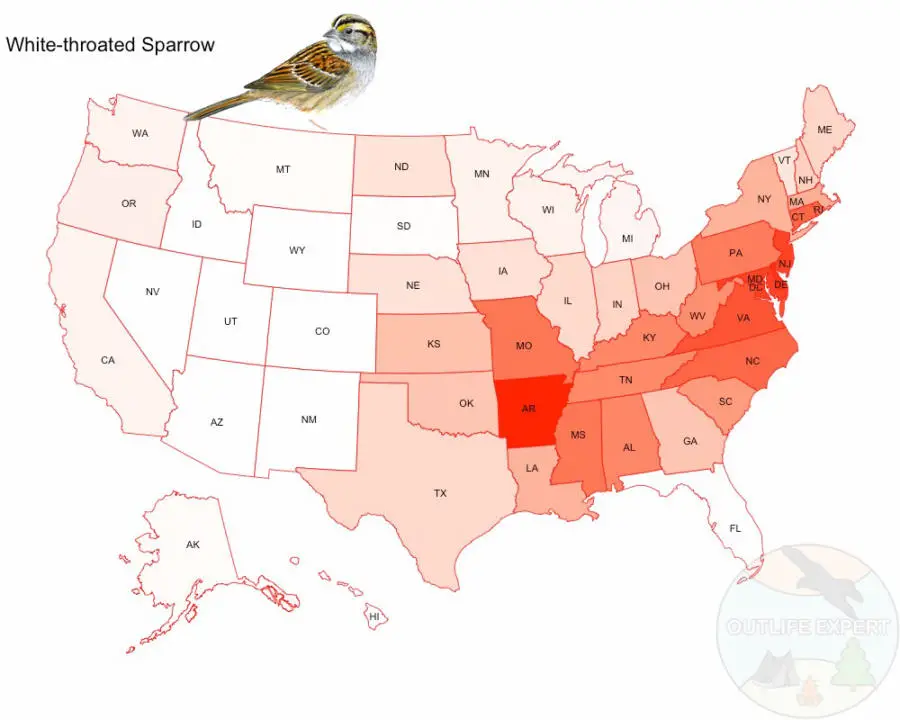
The stronger the red color, the higher the chance that you will see the White-throated Sparrow in your backyard.
Identification & Colour variation of the White-throated Sparrow
The White-throated Sparrow is a relatively large, full-bodied, sparrow with two distinctive colour morphs. They have brown plumage above, with gray below, a bright white throat and a yellow spot in front of the eye. The ëtan-stripedí morph has tan and dark brown head stripes, while the ëwhite-stripeí morph has clean black and white head stripes.
Different tempers of different color morphologies
In an extremely rare phenomenon in the bird world, the two-colour morphologies of this species behave very differently. The ëtan-stripedí morph is non-aggressive, very attentive to their young, and the females rarely sing. ëWhite-stripedí morphs are aggressive, make poor parents and males sing more than the ëtan-stripedí males. The two-colour morphs can be either male or female.
Mixed-morph breeding pairs are ideal as they balance these extremes in aggression and parenting.
Habitat and Migration Patterns
The White-throated Sparrow lives in deciduous or coniferous forests, forest edges, pond, and bog edges, and in areas of regrowth after forest fires. They prefer low, dense vegetation and do not venture above the treeline.
In the fall, they will migrate south from mid-September to early November and start flocking together for the winter. Their winter habitat consists of forest edges, brushy woodland, urban parks, wooded suburban neighbourhoods and backyards.
It is very uncommon to find winter flocks of White-throated Sparrows on the west coast. Come springtime, they will migrate north again from late-March to mid-May. During both spring and fall migration, they travel mostly at night.
Foraging and feeder preferences of the White-throated Sparrow
The White-throated Sparrow are ground foragers that mainly eat seeds and insects, but also eat fruit, buds, and grasses at various points throughout the year. They scratch through leaves on the ground with their feet and hop rather than run. During breeding season, these sparrows feed heavily on insects, including wasps, ants, true bugs, beetles, damselflies, spiders, millipedes, caterpillars, flies, and snails.
During winter, White-throated Sparrows rely primarily on seeds of grasses and weeds, and bird feeders. At backyard bird feeders they will eat millet, black oil, and hulled sunflower seeds, cracked corn, and milo out of platform feeders, or off the ground.
Biology and nesting of the White-throated Sparrow
The White-throated Sparrow breeds in coniferous and mixed forests, in areas of dense brush near water sources. During the nesting season from May to August, the female constructs the nest, primarily in the mornings.
The nest is an open cup shape made from grass, twigs, weeds, and pine needles, and is lined with grass, animal hair and moss. The nest is usually on the ground, and is well hidden by shrubs or other fauna. White-throated Sparrows donít reuse nests, so each season the female will construct a new one.
Occasionally, females will build nests up to 15 feet off of the ground in brush piles, upturned trees, shrubs, ferns, or conifers. This extreme precaution is mostly taken when their first nest has been robbed by predators.
The female may have 1-2 broods per season, and lay anywhere from 1-6 eggs each time. The female sits on the eggs for 11-14 days and the fledglings will leave the nest approximately 7-12 days after hatching. The nestlings are fed by both parents, and fledglings are taken care of by both parents for about 2 weeks after leaving the nest.
White-throated Sparrows will almost always pair up with the opposite colour morph. Pairs will stay together through the summer and choose new partners the next breeding season.
Occasionally, the White-throated Sparrow will mate with the Dark-eyed Junco, breeding a hybrid bird that looks like a gray White-throated Sparrow with white outer tail feathers.
Behaviour & Hierarchies
During the breeding season males are extremely aggressive, they sing and even chase off other birds to defend their territory. This aggression declines as the breeding season draws to a close, and by the fall form flocks that forage together for the winter.
In these winter flocks, there exists a hierarchy. While colour morph has nothing to do with their status in the hierarchy, males are dominant over females.
In South Carolina, the the number of White-throated Sparrows has increased over the last 30 years with more than double the number since the mid 1990s.
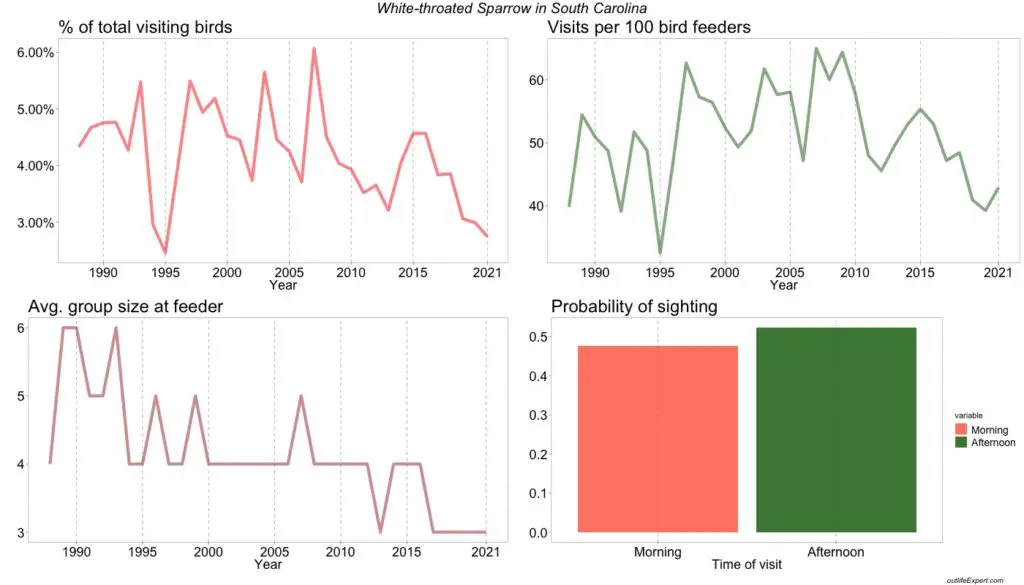
% of total visiting birds: The proportion of the specific bird out of the total number of birds observed bird feeders in this state.
% of total feeders visited: The proportion of feeders (out of all participating feeders in the state each year) where the bird was observed at least once within 2 days.
Avg. group size at feeder: The average number of birds counted simultaneously for each bird feeder observation.
Probability of sighting: The chance of spotting the bird in either morning (before 12 noon) or afternoon (after 12 noon). If both are 0.5 there is an equal chance of spotting the bird in the morning and afternoon.
White-breasted Nuthatch (Sitta carolinensis) in South Carolina
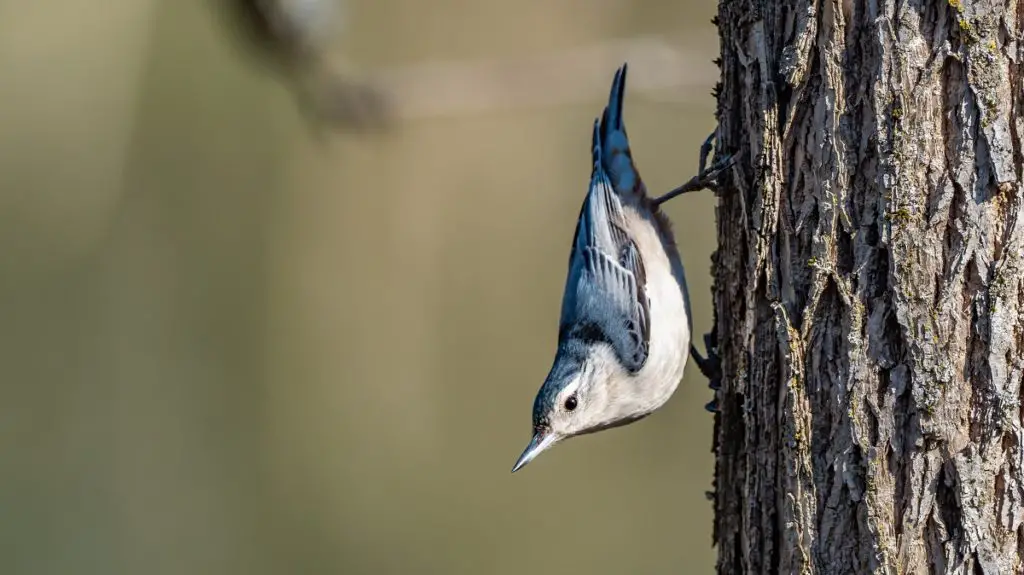
Family: Sittidae
Occurrence: Throughout United States, Canada, and Mexico when forest is present.
Diet in the wild: Insects in the summer, seeds in the winter.
Feeder type preferences:
- Large tube feeder
- Small tube feeder
- Suet Cage
- Large hopper feeder
- Small hopper feeder
- Platform feeder
Feeder food preferences:
- Suet
- Black Oil Sunflower Seeds
- Hulled Sunflower Seeds
- Safflower
- Mealworms
- Crushed peanuts
- Whole peanuts
Endangered: No.
The white-breasted nuthatch is a common garden bird in western Canada, large parts of Mexico, and most of the US (except for Alaska, Nevada and Louisiana).
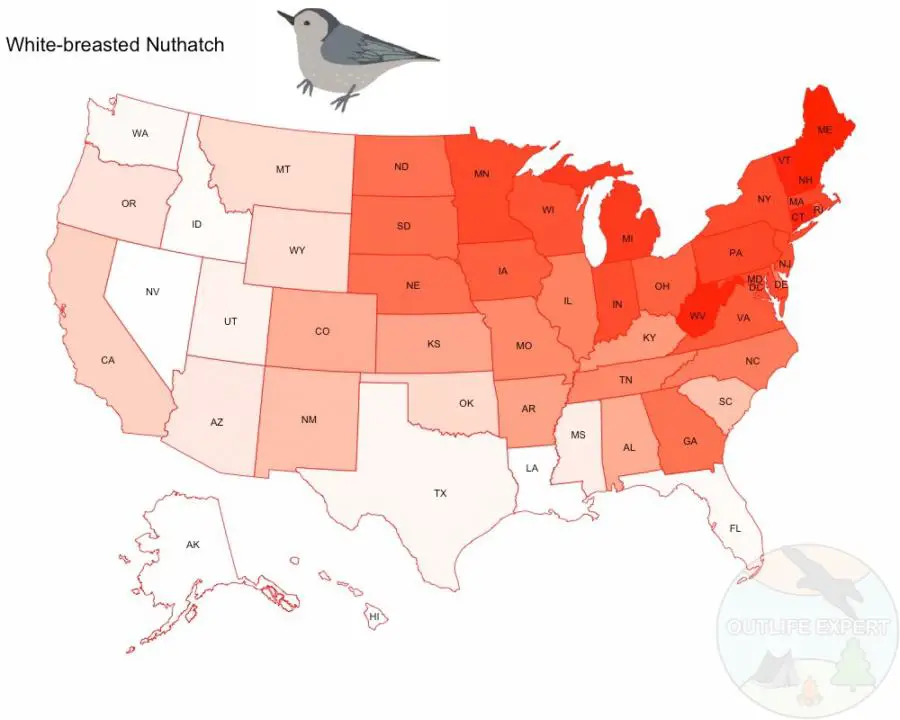
The stronger the red color, the higher the chance that you will see the white-breasted nuthatch in your backyard.
They get their common name from their white breast and their habit to wedge a food item in a crevice and hack them open with their strong bills. They are mostly found in monogamous pairs, but during winter they will sometimes flock with other bird species. They belong to the nuthatch family, Sittidae, and are closely related to wallcreepers, treecreepers, wrens, and gnatcatchers.
There are three other nuthatches in North America: the red-breasted nuthatch, the brown-headed nuthatch, and the pygmy nuthatch.
Identifying the white-breasted nuthatch
White-breasted nuthatches are 5 to 6 inches, have a large head, short tail and wings, and a strong bill and feet. They have blue-grey upperparts with white underparts and face and a black cap extending down to a black bar across the nape of its neck.
They have black and white markings on their wings and tail and a rust-colored undertail.
Females have a slightly narrower nape band, and their coloring is slightly less contrasted than that of the male and their cap is sometimes grey. However, it is often difficult to distinguish males from females in the field.
Juveniles have duller plumage than the adults. They have a wide repertoire of vocalizations, but their most distinctive vocalization is a ìKri-Kri-Kri-Kriî call. There are nine subspecies of white-breasted nuthatch, all visually similar with only slight variations in color, size and bill shape.
None of the other nuthatches in North America have a completely white face. The red-breasted nuthatch has a black eye line, white brow, and a reddish breast. Both the brown-headed nuthatch and the pygmy nuthatch are smaller and have a brown cap instead of black. In the black-capped chickadee, the black cap covers its eyes, and it has a black bib.
Where and when does the white-breasted nuthatch nest?
The white-breasted nuthatch breeds in woodland habitats across North America. Their breeding season is between May and June. The male performs a courtship ritual where he spreads his tail, droops is wings and bows to the female while he sways back and forth.
They use natural cavities or old woodpecker nests in trees for nesting. They form a cup of bark, grasses, twigs, and hair. They will lay five to nine eggs, each less than an inch long, cream colored with brown speckles.
In summer, they eat mostly insects, but in winter, when insects are in short supply, they supplement their diet with seeds and nuts. Their chicks feed almost exclusively on insects.
During autumn and winter, they will stash food from bird feeders in bark crevices for later use.
How to attract the white-breasted nuthatch to your garden
The white-breasted nuthatch will visit birdfeeders for sunflower seeds, peanuts, suet, and mealworms.
In your garden you can plant large trees such as oak, beech and hickory to provide food and potential nesting sites.
Create an insect-friendly garden with lots of indigenous plants and shrubs, a thick mulch layer and dead logs.
Do not use insecticides in your garden. Insecticides not only kill the insects that birds feed on, but could also result in secondary poisoning when birds eat poisoned insects.
Is the white-breasted nuthatch endangered?
The white-breasted nuthatch is listed as least concern, since its population is increasing. However, forest clearance and the removal of dead trees can lead to reduced numbers locally, but may lead to more white-breasted nuthatches to seek towards backyards and birdfeeders in cities.
Their natural predators include birds of prey and snakes. Squirrels compete with nuthatches for tree cavities and will eat their chicks and eggs. Despite these threats, the white-breasted nuthatch is doing quite well in South Carolina.
The increased threat of wildfires and spring heat waves due to climate change is causing a northward range shift, which could cause them to go locally extinct in the southern states of their distribution.
From the graph below, you will see that the white-breasted nuthatch is actually getting increasingly more common at bird feeders in South Carolina. However, this does not necessarily mean that its general population is increasing. It could also mean that the nuthatches seek from the forest towards the cities to obtain food. Either because their habitats are disappearing or simply because backyards are getting more attractive, e.g having more trees or bird feeders, for the nuthatches to enjoy.
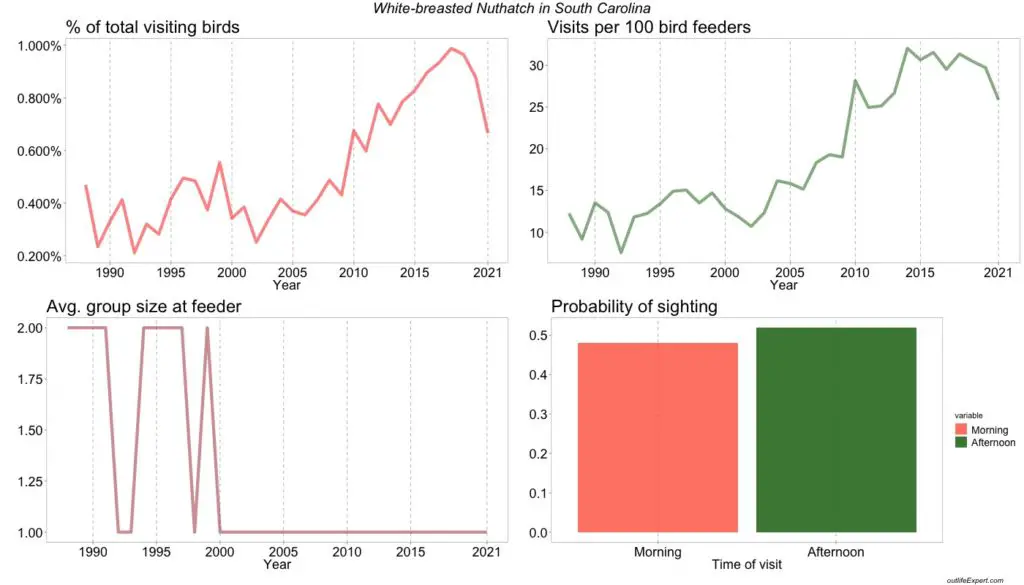
% of total visiting birds: The proportion of the specific bird out of the total number of birds observed bird feeders in this state.
% of total feeders visited: The proportion of feeders (out of all participating feeders in the state each year) where the bird was observed at least once within 2 days.
Avg. group size at feeder: The average number of birds counted simultaneously for each bird feeder observation.
Probability of sighting: The chance of spotting the bird in either morning (before 12 noon) or afternoon (after 12 noon). If both are 0.5 there is an equal chance of spotting the bird in the morning and afternoon.
Backyard birds in other states
Are you interested in how the backyard birds in your state compare to other states?
Then check out my other blog posts below:
- Backyard birds of Alabama
- Backyard birds of Colorado
- Backyard birds of Delaware
- Backyard birds of Georgia
- Backyard birds of Hawaii
- Backyard birds of Illinois
- Backyard birds of Iowa
- Backyard birds of Kentucky
- Backyard birds of Louisiana
- Backyard birds of Maryland
- Backyard birds of Massachusetts
- Backyard birds of Missouri
- Backyard birds of Nebraska
- Backyard birds of New York
- Backyard birds of North Carolina
- Backyard birds of Oklahoma
- Backyard birds of Rhode Island
- Backyard birds of South Carolina
- Backyard birds of Tennessee
- Backyard birds of Texas
- Backyard birds of Virginia
- Backyard birds of West Virginia
- Backyard birds of Wisconsin
- Backyard birds of Wyoming
And in Canada:
- Backyard birds of Ontario
- Backyard birds of Prince Edward Island
- Backyard birds of Saskatchewan
- Backyard birds of Quebec
Not on the list? Check out the rest of my posts on backyard birds here!
Maybe you would like to know if the Blue Jay or Cardinal dominates in the bird feeder hierarchy or how birds such as seagulls sleep at night? Or why mourning doves poop so much and whether most birds can poop and fly at the same time!
A lightweight handy pair of binoculars is a must for your backyard bird watching! Check out my recent post on the best small lightweight binoculars for birdwatching etc.
My Favorite Backyard Birding Gear:
- Photographs and identifies birds coming to your bird feeder!
- Notifies you via the app whenever a bird stops by!
- Excellent resolution and battery performance with the 6MP image sensor.
- Connect from anywhere with internet access (watch birds even when you are not at home!)
- Count the birds visiting your feeder and contribute to projects such as FeederWatch!
If you are interested in posters and other wall arts etc. with drawings of all the backyard birds you have just read about, check out my portfolio over at Redbubble:
Acknowledgements
I want to thank the Cornell Lab of Ornithology at Cornell University and the Birds Canada organization as well as all the citizens who have been involved in the FeederWatch project for providing the data of this article. The data I have used to generate the prevalence numbers for this article is provided by the FeederWatch project. The FeederWatch project is an initiative by The Cornell Lab of Ornithology at Cornell University and the Birds Canada organization. The data is collected through an immense crowdsourced citizen science program, where citizens of the United States and Canada are invited to count birds at their bird feeders, identify the species, and report back to the scientists at Cornell University. The birds are counted from November to April and always in two consecutive days including only one area with a bird feeder, typically a piece of the backyard, observed from one vantage point. The two-day watch is then repeated throughout the season. The data is collected each year and is freely available to the public at https://feederwatch.org/.
References
American Museum of Natural History Birds of North America. DK; Revised edition (September 6, 2016). ISBN: 978-1465443991
National Geographic Backyard Guide to the Birds of North America, 2nd Edition. National Geographic; 2nd edition (October 15, 2019)
Birds of North America. National Audubon Society. (Knopf April 6, 2021). ISBN: 978-0525655671

